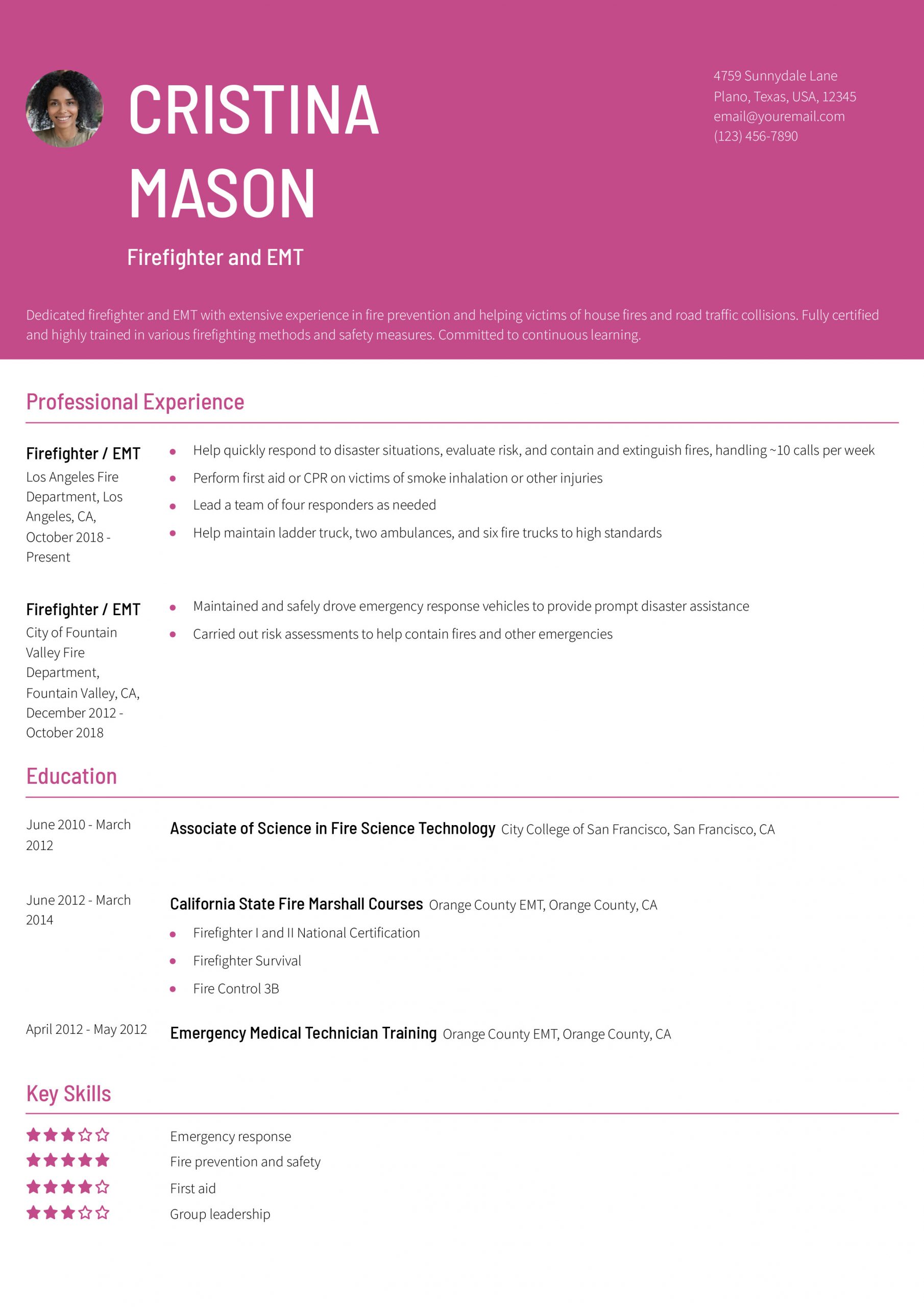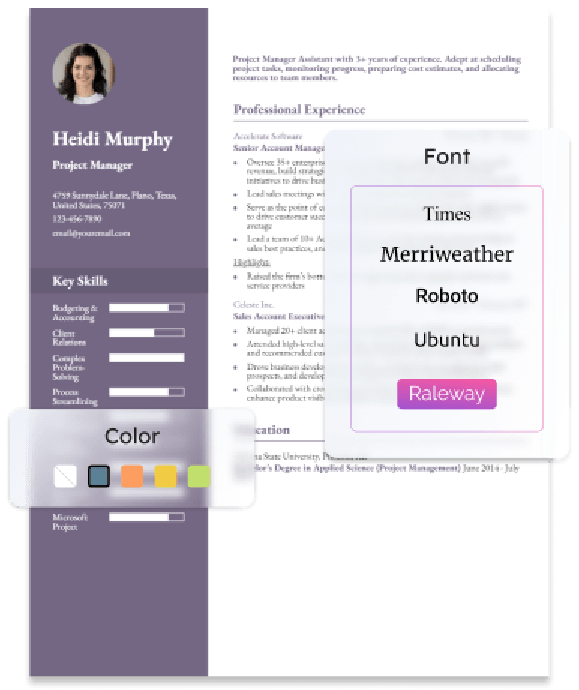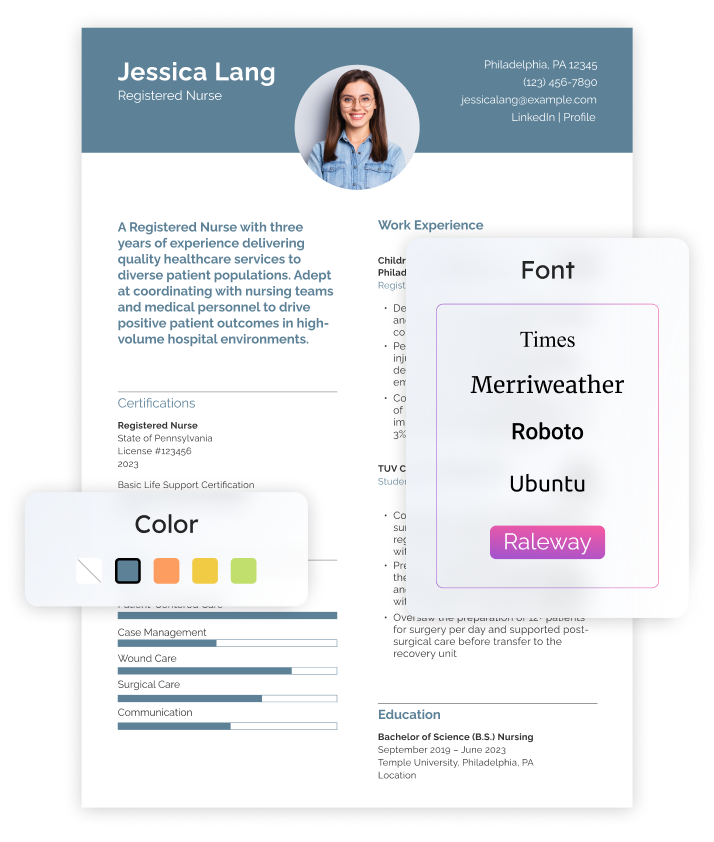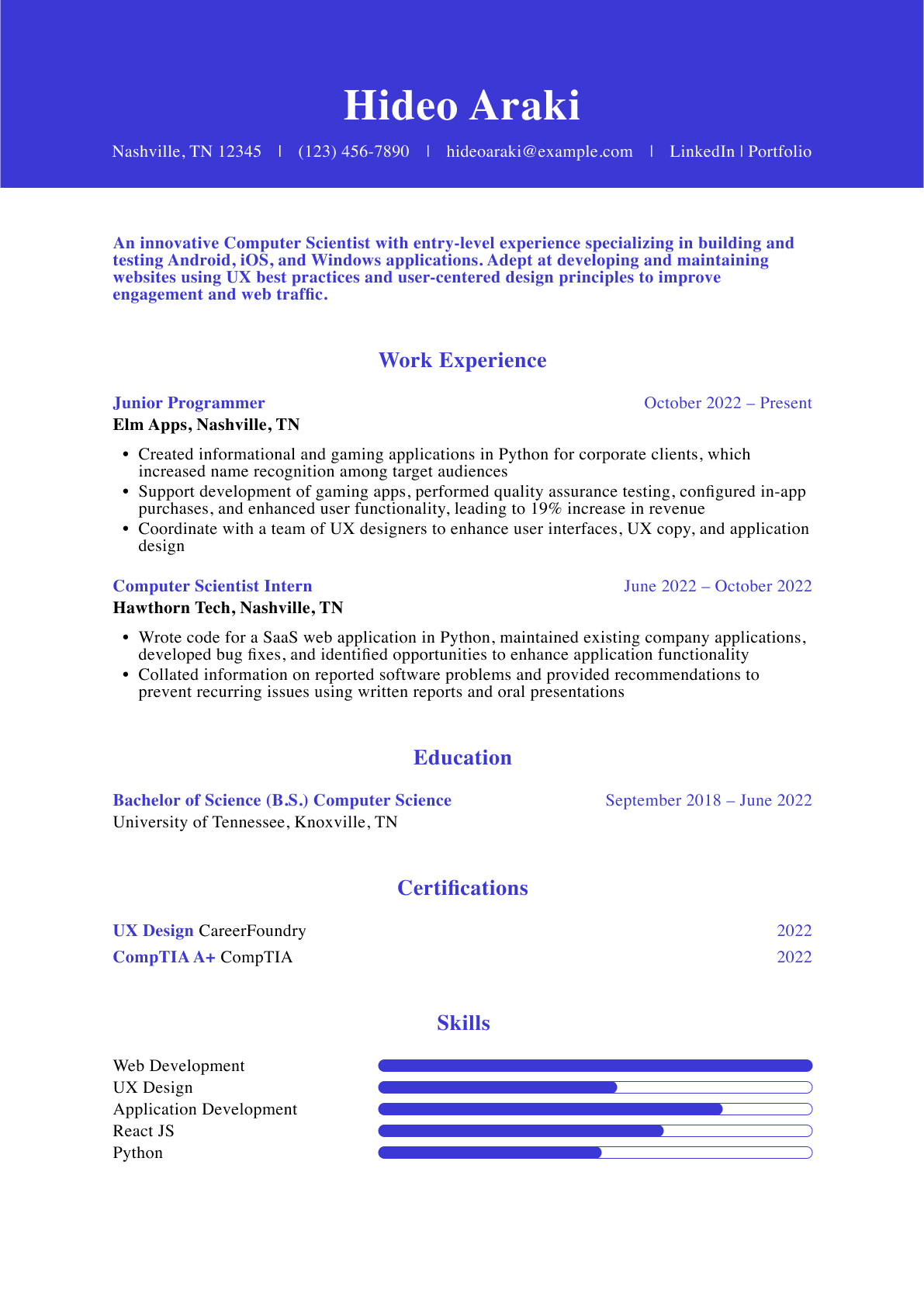To write a good firefighter resume, you’ll need to show you can quickly respond to fires and other emergencies that may arise in your community. The tips below will help you capture this skill in each section of your resume so it gets you interviews for your next firefighter job.
Most Popular Firefighter Resumes
Entry-Level Firefighter Resume
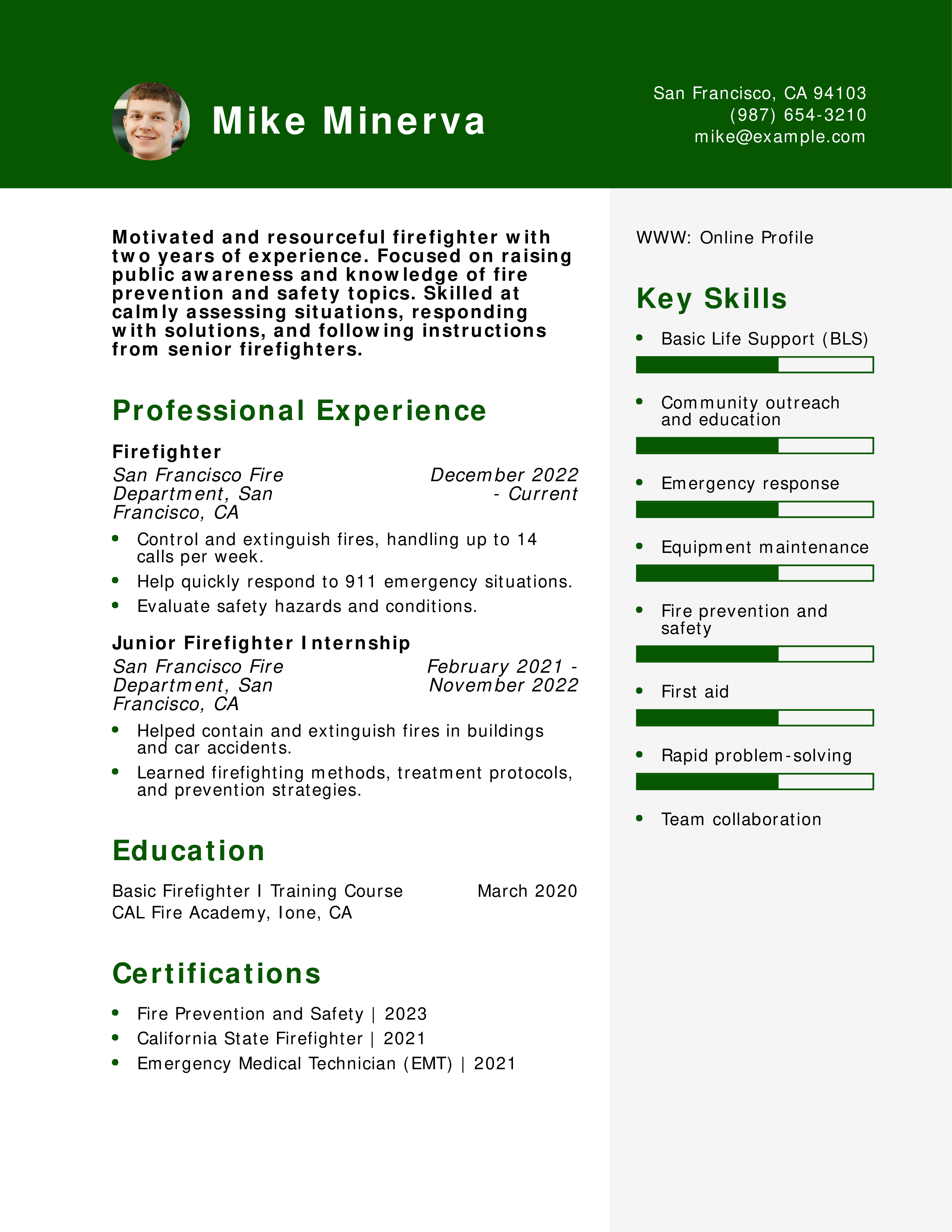
Why This Resume Works
This resume showcases a solid foundation in firefighting and emergency response, highlighting both hands-on experience and key certifications like EMT and Fire Prevention and Safety. The candidate’s internship experience helps demonstrate their growth, while the professional experience section details their ability to handle real-world emergencies. The inclusion of relevant skills, such as equipment maintenance and team collaboration, further reinforces the candidate's readiness to perform as an entry-level firefighter.
For additional tips, visit Resume Skills.
Mid-Career Firefighter Resume
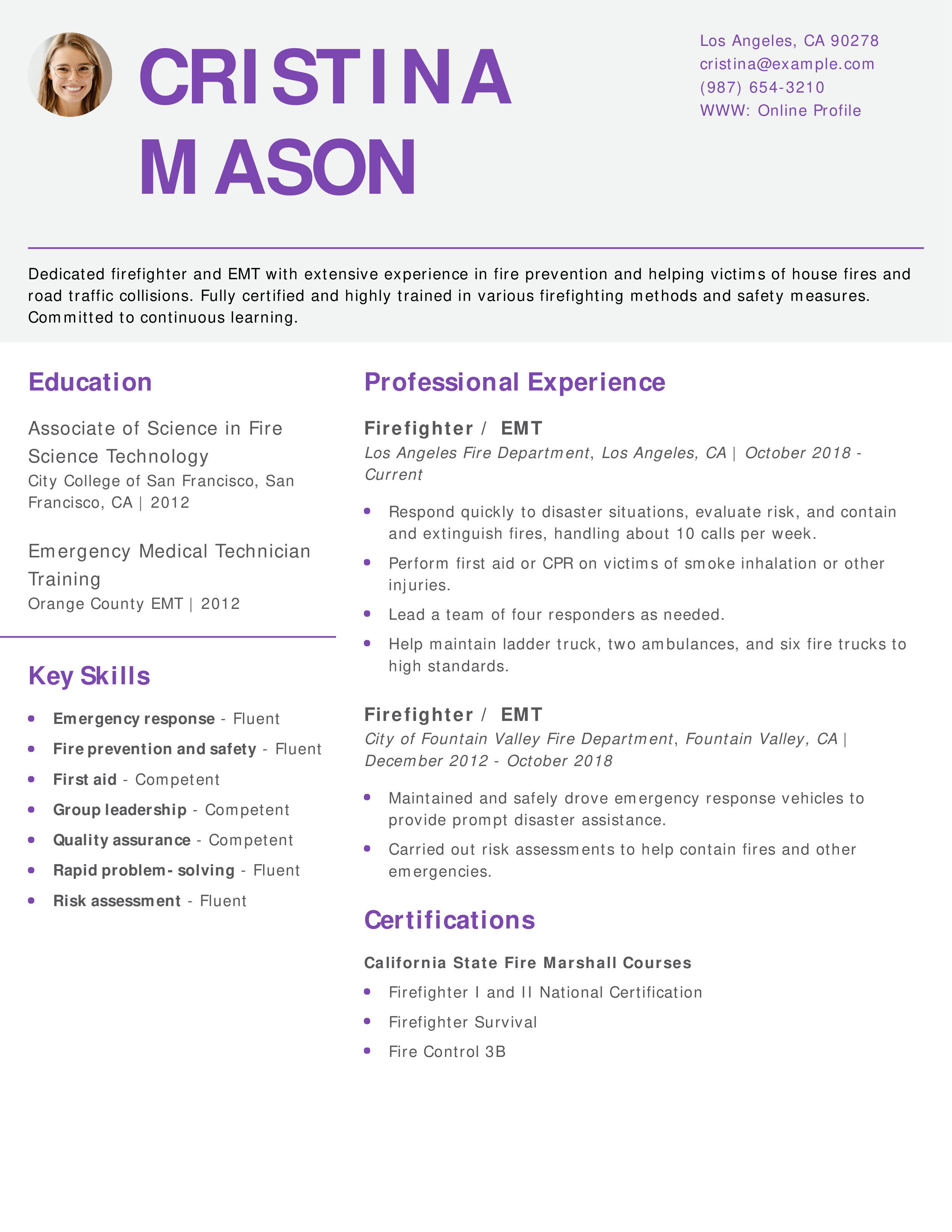
Why This Resume Works
This resume emphasizes extensive experience in both firefighting and emergency medical services, underscoring the candidate's well-rounded skill set. The progression of roles from different departments adds depth to their experience, and leadership skills are showcased by highlighting team management responsibilities. Certifications, combined with a record of handling complex emergencies, make this candidate stand out in mid-career firefighting roles.
For more insights, visit Resume Summary Examples.
Senior-Level Firefighter Resume
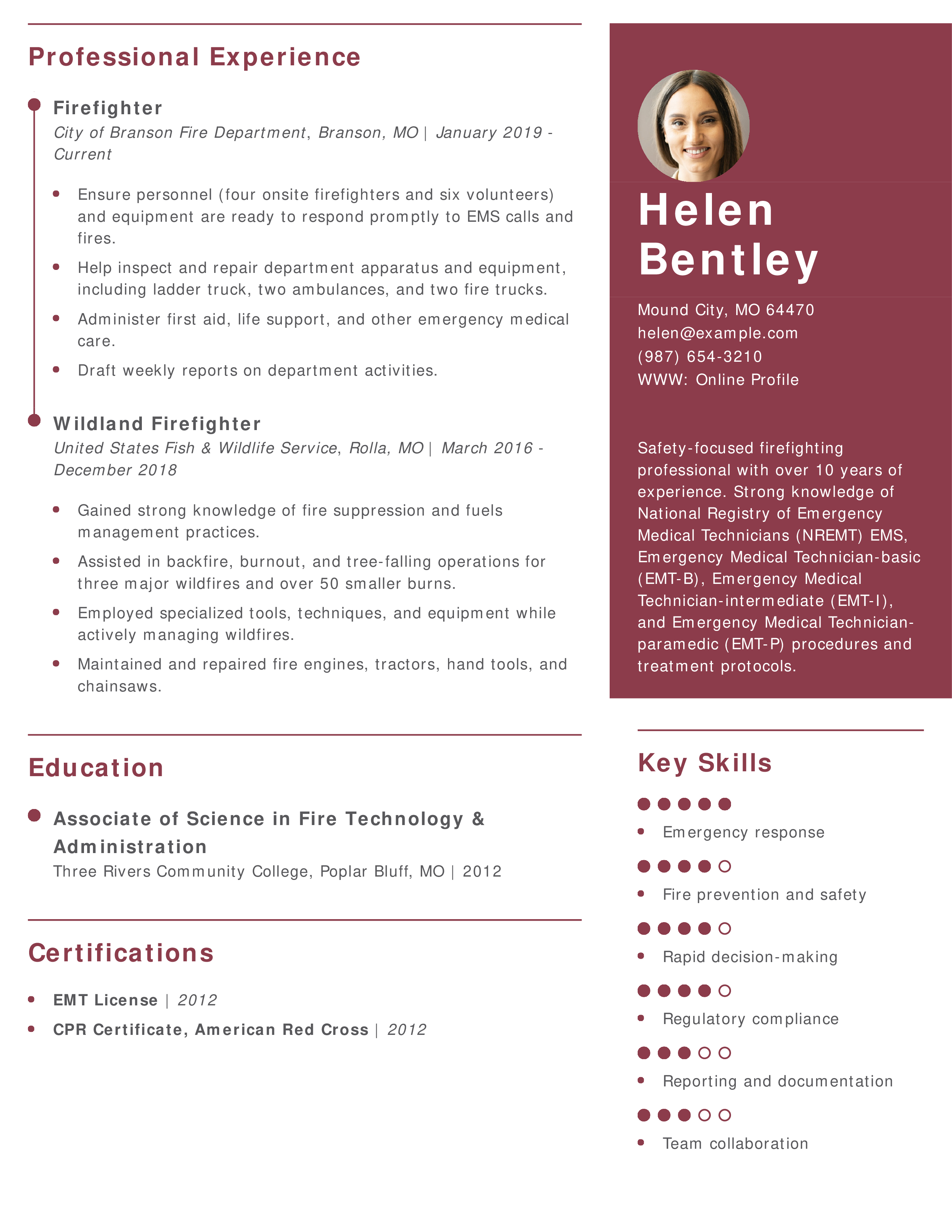
Why This Resume Works
This resume highlights the candidate's 10+ years of experience and leadership in emergency services, demonstrating their ability to manage teams and handle diverse fire scenarios, including wildland fires. The emphasis on regulatory compliance, equipment maintenance, and fire suppression techniques showcases a high level of expertise. Additionally, the candidate’s ability to draft reports and maintain operational readiness strengthens their qualifications for senior firefighting positions.
For additional tips on certifications, check out How to List Certifications on Resume.
Certified Emergency Medical Technician Resume
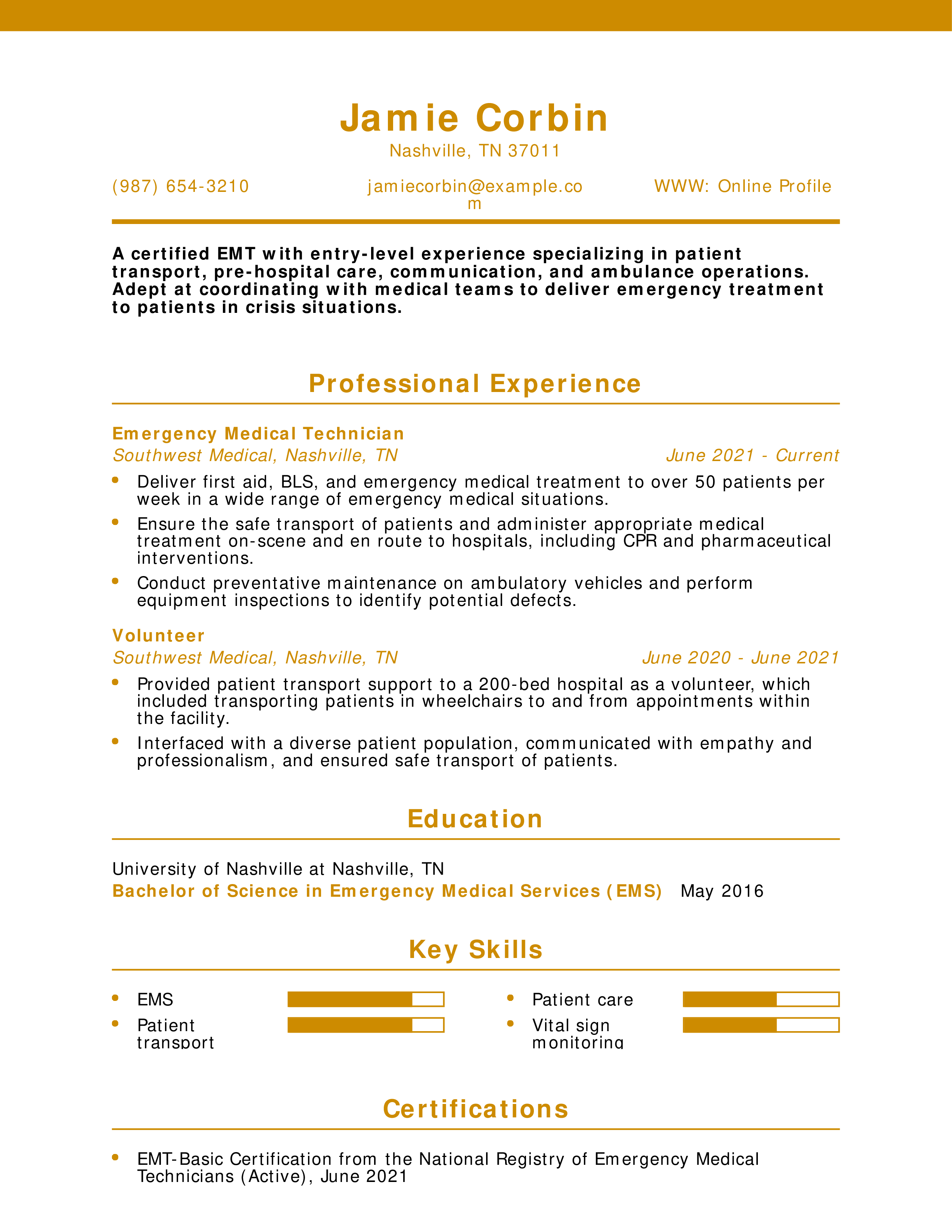
Why This Resume Works
This entry-level EMT resume effectively highlights relevant skills such as patient transport, communication, and pre-hospital care, with a focus on patient interaction and care quality. The candidate’s experience in delivering emergency treatment to over 50 patients per week shows a high level of involvement and reliability. Volunteer experience is also leveraged well, demonstrating commitment to the field and the ability to work in high-pressure situations.
For more insights on what to include in your resume, visit What to Put on a Resume.
Hospital EMT Resume
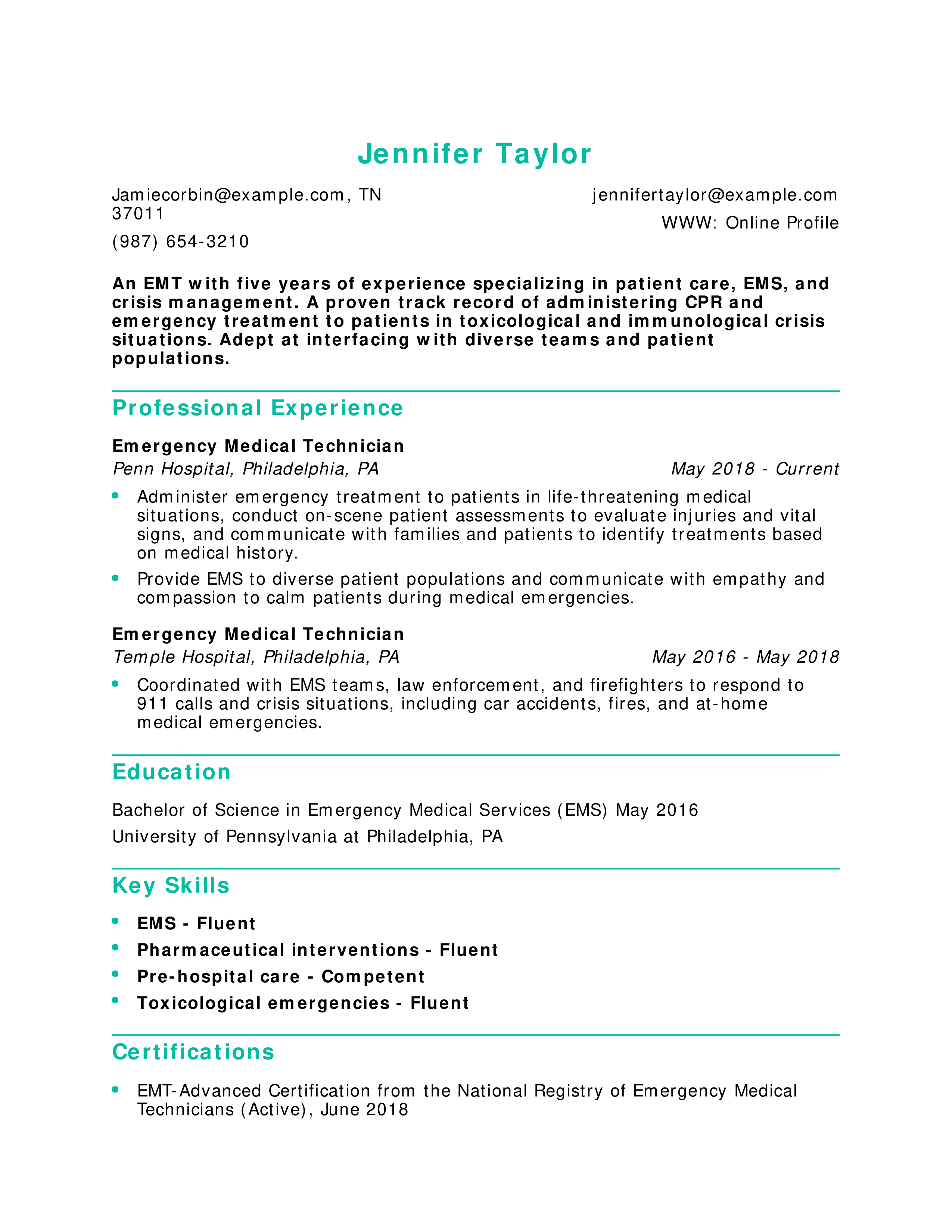
Why This Resume Works
This resume highlights five years of experience providing life-saving care during emergencies, particularly toxicological and immunological crises. The candidate's expertise in pre-hospital care, CPR, and pharmaceutical interventions is reinforced by measurable achievements, such as managing diverse patient populations and working in tandem with EMS teams. The candidate’s experience at reputable hospitals and extensive certifications make them well-suited for higher-level EMT roles.
For more tips on listing certifications and skills, visit How to List Certifications on Resume.
Emergency Medical Technician Resume
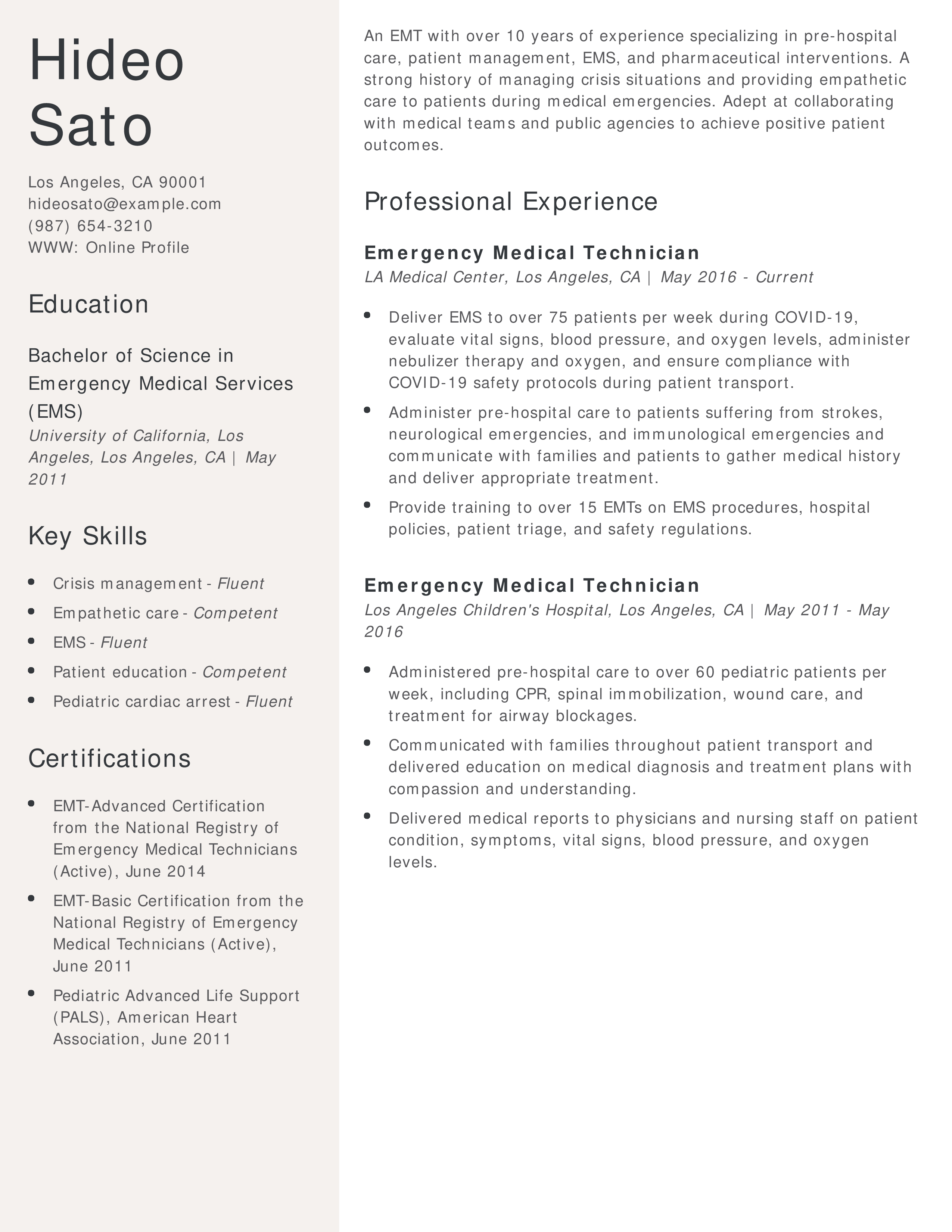
Why This Resume Works
This resume emphasizes the candidate’s extensive experience and crisis management skills developed over a 10-year career. The focus on pandemic response and high patient volume showcases the candidate’s resilience and adaptability during critical situations. Additionally, their leadership role in training other EMTs and knowledge of pediatric emergencies further reinforces their suitability for senior EMT positions. Strong skills in patient education and empathetic care add a personal touch to the resume, highlighting the candidate’s compassionate approach to patient management.
Learn how to showcase your leadership and certifications with Resume Outline Examples.
Beginner Volunteer Firefighter Resume
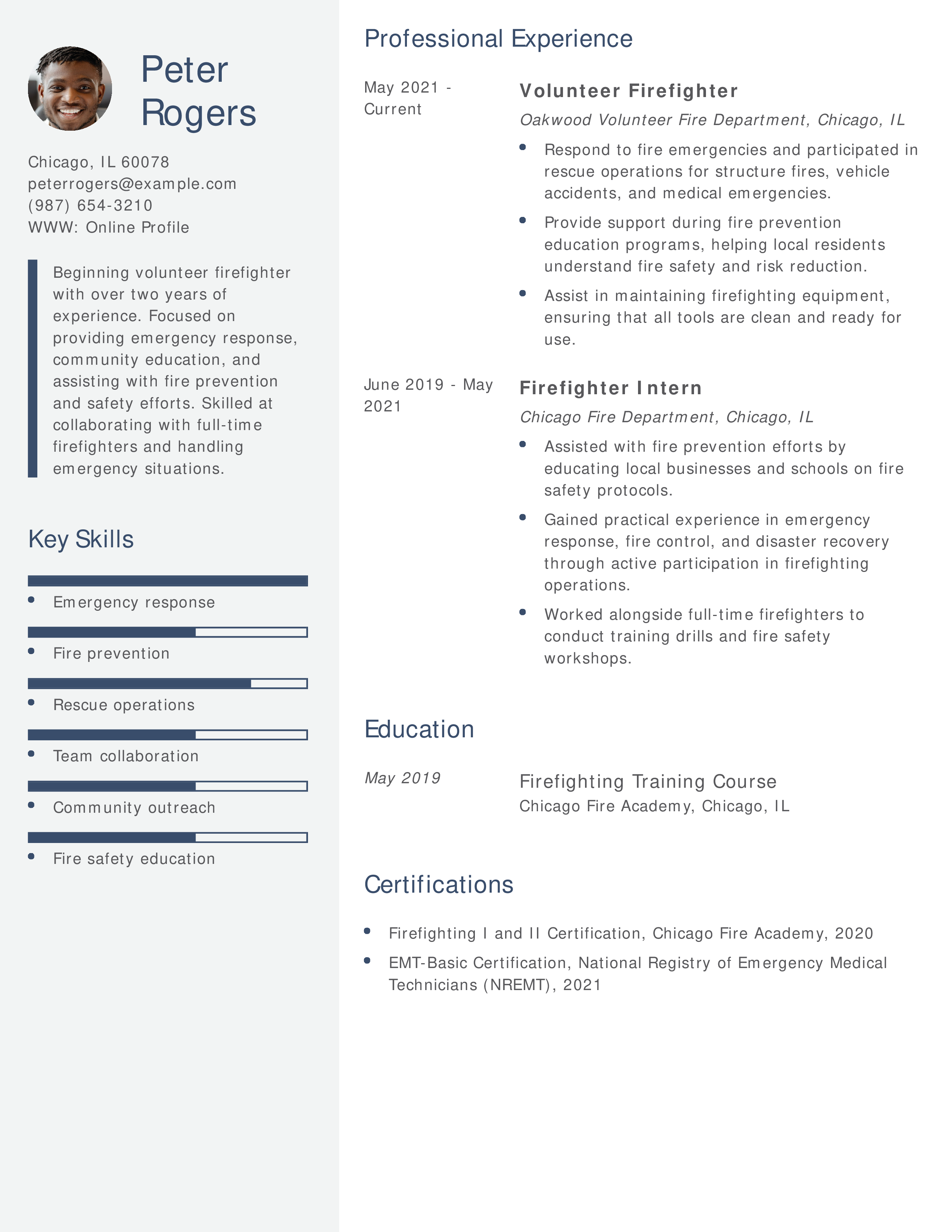
Why This Resume Works
This resume highlights the candidate’s commitment to volunteer firefighting, showcasing hands-on experience in both emergency response and fire safety education. By including internship experience alongside volunteer work, the candidate demonstrates a proactive attitude and a strong desire to gain skills in real-world environments. Certifications and training courses add credibility to the resume and make the candidate appealing for future firefighting positions.
Learn how to present your educational experiences effectively with How to List Your Education on a Resume.
Wildland Firefighter Resume
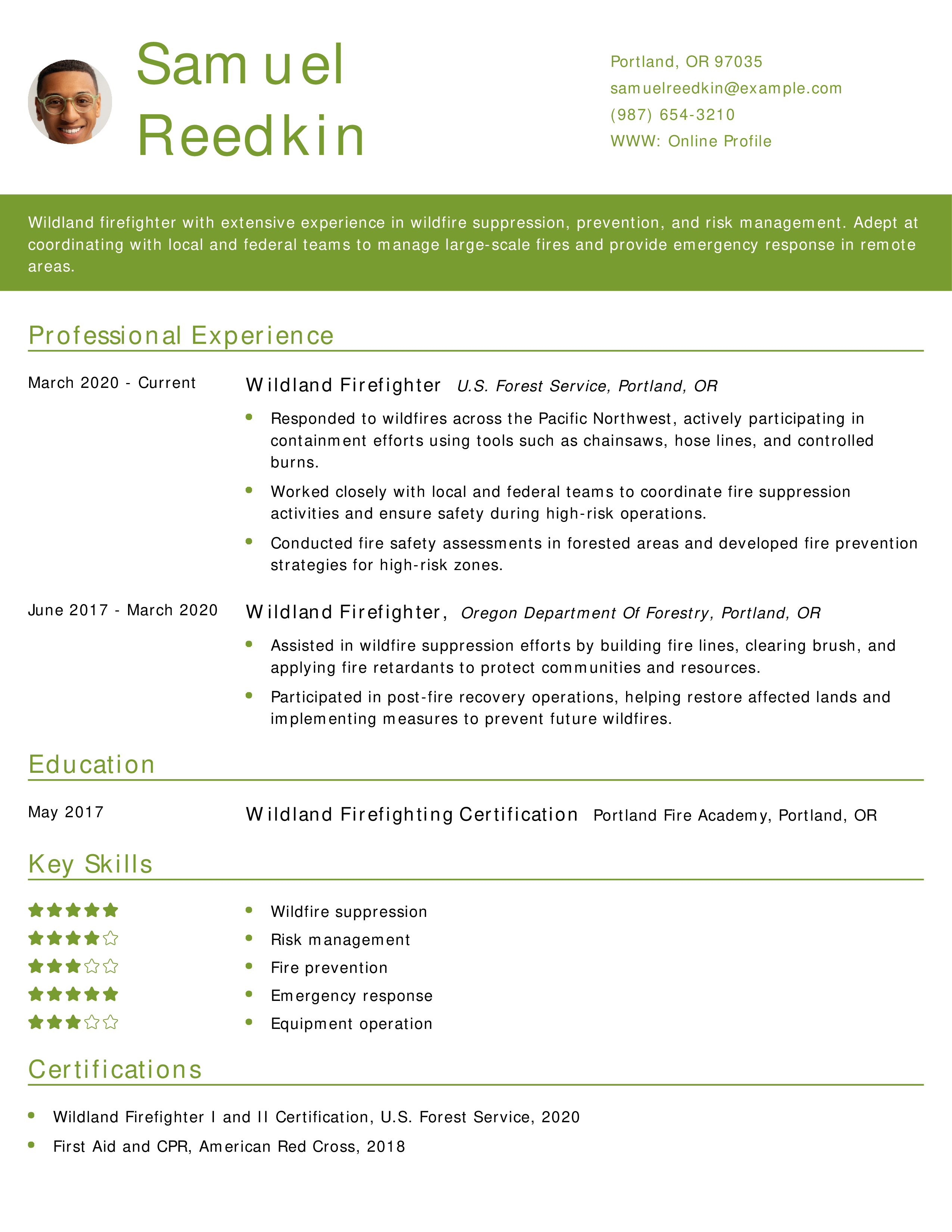
Why This Resume Works
This resume emphasizes the candidate’s specialized knowledge in wildland firefighting and highlights a proven track record of success in wildfire suppression. The focus on teamwork, physical endurance, and regulatory compliance makes this resume strong for positions in wildland firefighting roles.
Learn more about how to list certifications with How to List Certifications on Resume.
Firefighter Paramedic With Trauma Care Resume
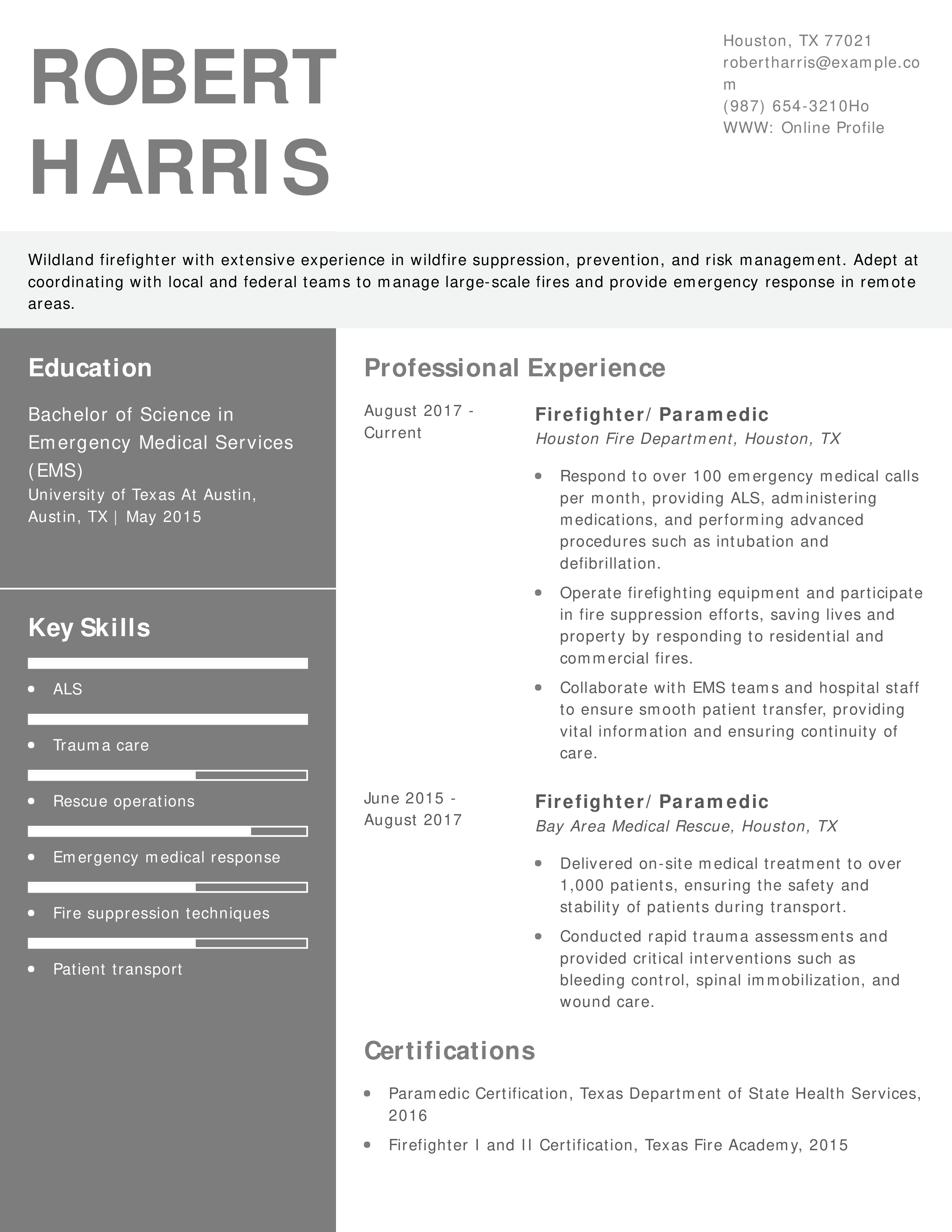
Why This Resume Works
This resume highlights the candidate’s dual qualifications in firefighting and emergency medical care, underscoring their ability to handle complex and high-pressure situations. The inclusion of quantifiable data, such as responding to over 100 emergency calls per month, demonstrates a strong work ethic and reliability. Certifications and training in ALS, ACLS, and PALS reinforce the candidate’s preparedness for advanced medical care roles.
Learn how to make your resume stand out by checking out How to Make a Resume.
Firefighter EMT Resume
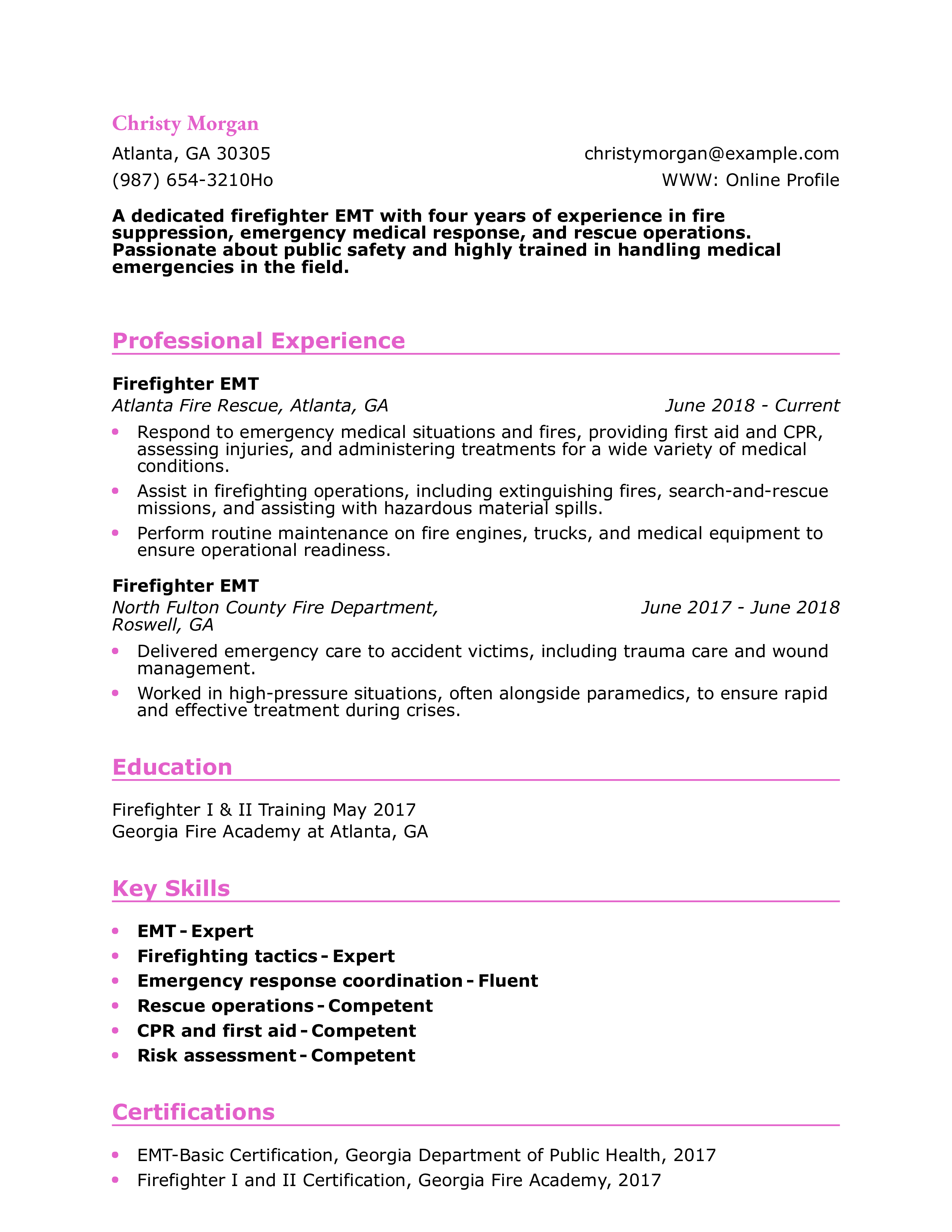
Why This Resume Works
This resume effectively blends firefighting skills with medical expertise, providing a comprehensive view of the candidate’s abilities. The inclusion of both firefighting and medical response duties showcases the candidate’s versatility. Specific certifications and hands-on experience, including fire suppression and emergency medical services, make this candidate well-qualified for a firefighter EMT role.
To learn more about presenting your skills effectively, check out Resume Skills.
Firefighter Resume
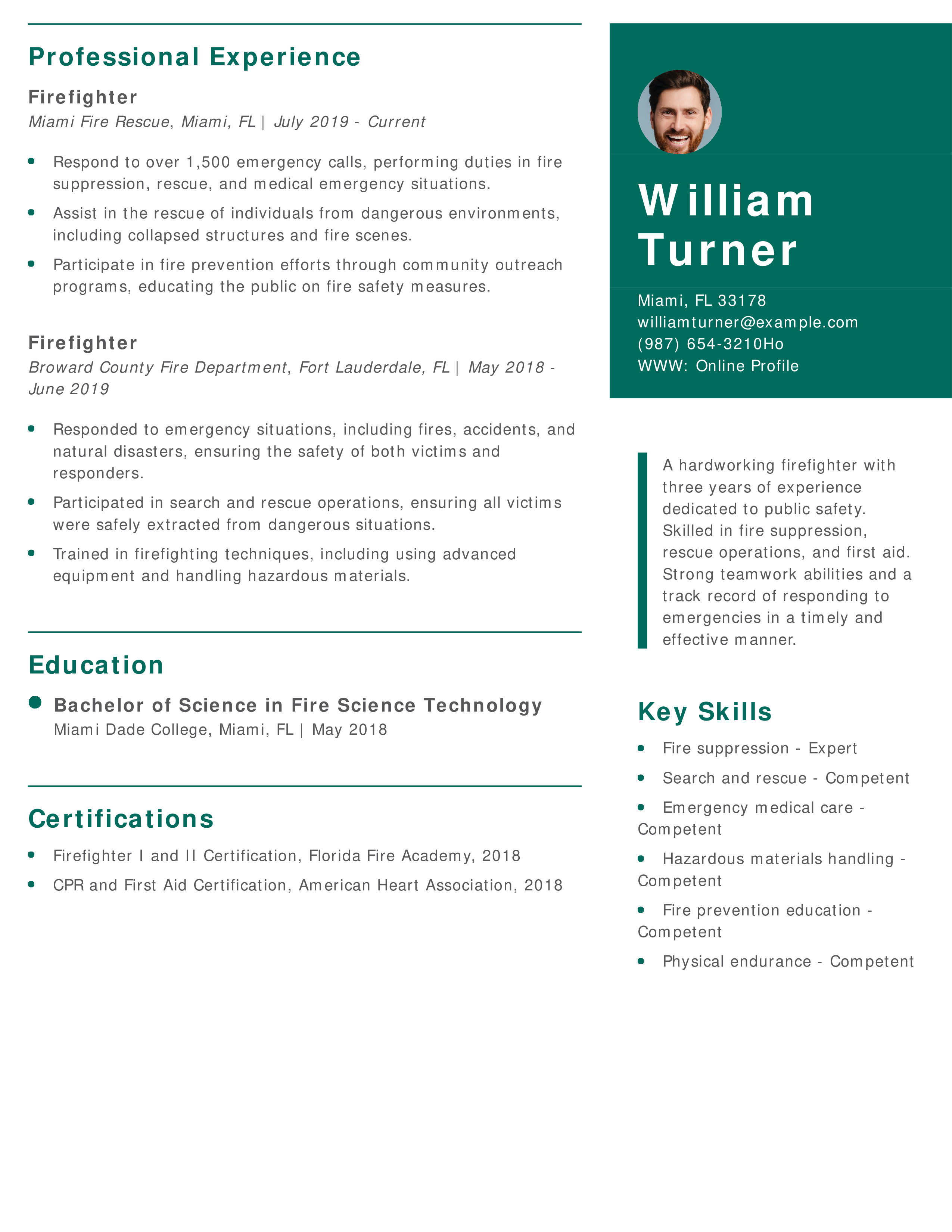
Why This Resume Works
This resume highlights the candidate’s strong background in fire suppression, rescue operations, and emergency medical care. It showcases a variety of essential skills, including hazardous materials handling and community education, demonstrating a well-rounded firefighter capable of taking on various roles in emergency response. The inclusion of certifications, such as Firefighter I and II, helps to solidify the candidate’s readiness for firefighting roles.
For more tips on structuring your resume, visit Best Resume Formats.
Mid-Level Wildland Firefighter Resume
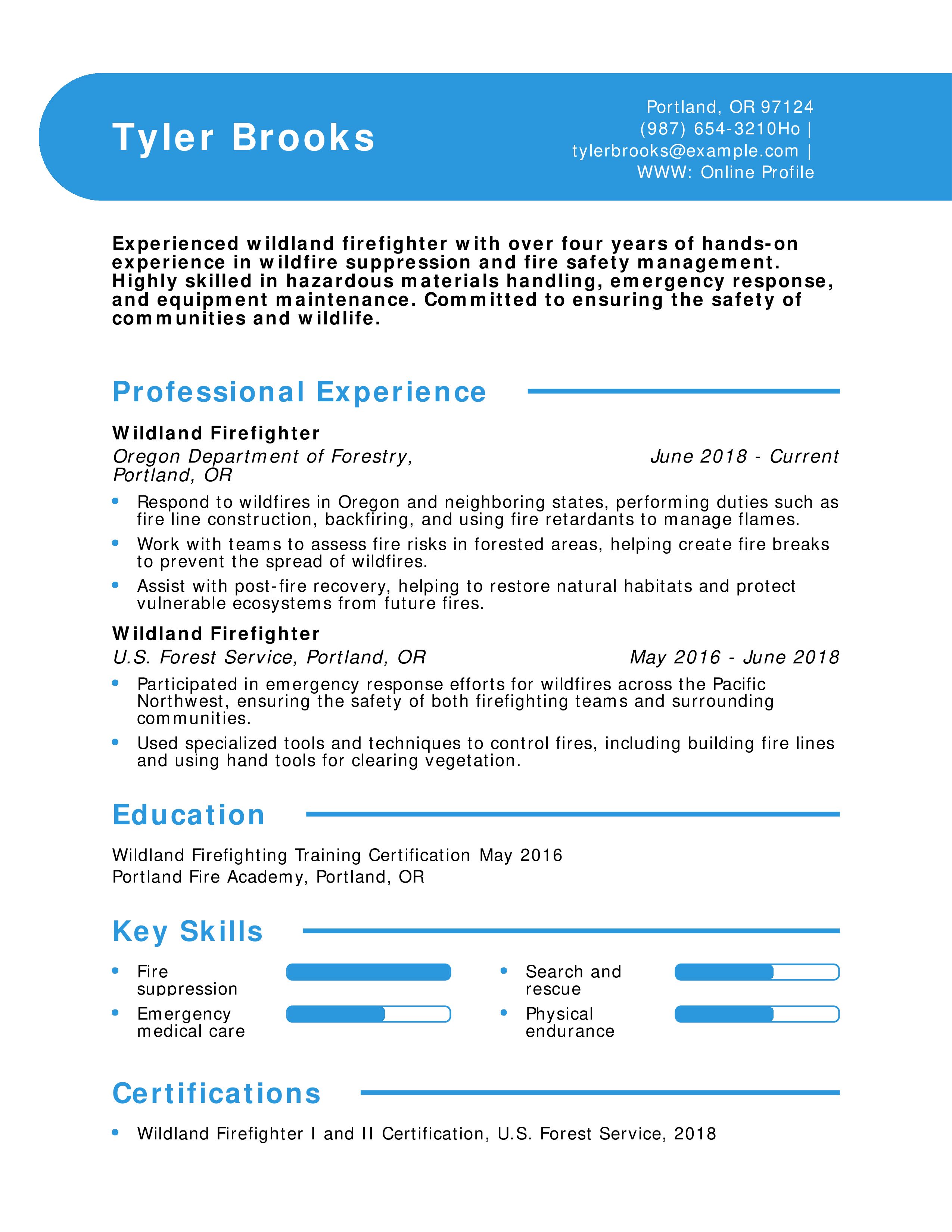
Why This Resume Works
This resume is effective because it focuses on the candidate’s specialized skills and hands-on experience in wildland firefighting. The candidate demonstrates knowledge of fire suppression, fire prevention, and post-fire recovery, essential for roles in wildland firefighting. Specific certifications, including Wildland Firefighter I and II, make this candidate well-qualified for similar positions.
For more tips on highlighting relevant training, visit How To List Certifications on Resume.
Firefighter Paramedic Resume
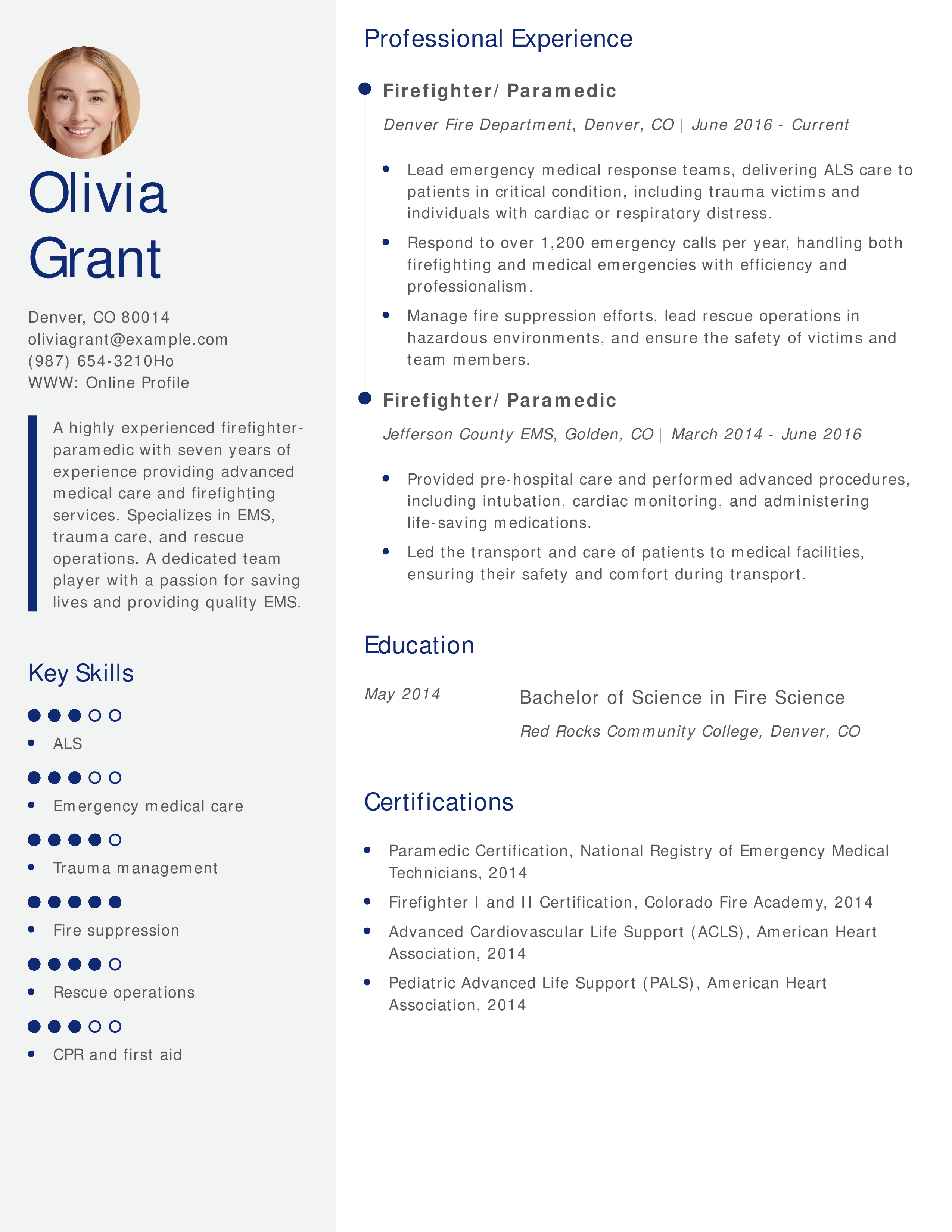
Why This Resume Works
This resume effectively highlights the candidate's dual expertise in both firefighting and EMS. By emphasizing both ALS certifications and fire suppression experience, it positions the candidate as a well-rounded first responder capable of managing high-stress emergency situations. Specific measurable achievements such as handling over 1,200 emergency calls per year provide a clear demonstration of the candidate’s abilities.
For tips on how to highlight certifications effectively, visit How to List Certifications on Resume.
Mid-Level Firefighter Resume
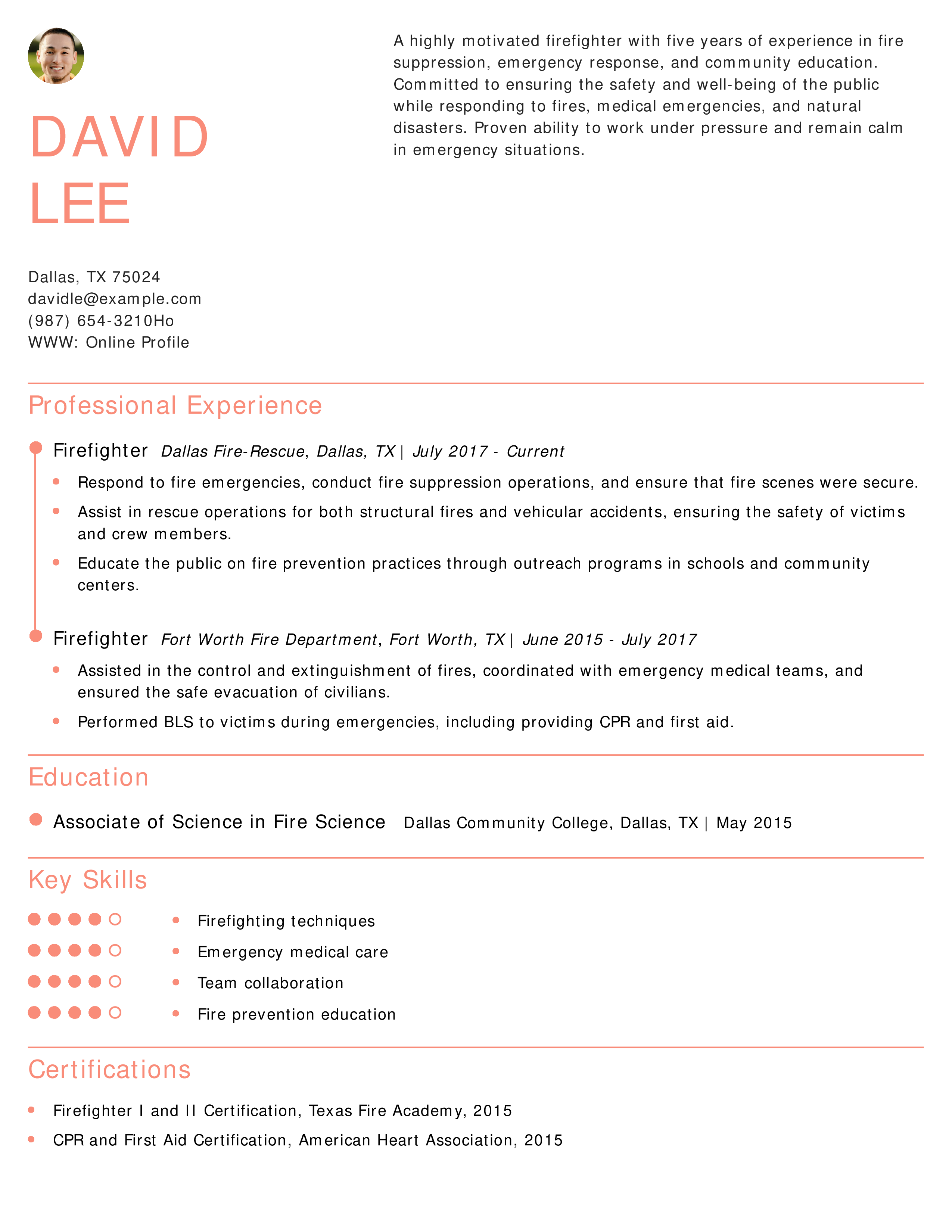
Why This Resume Works
This resume clearly outlines the candidate’s firefighting experience while showcasing the practical skills required in this line of work. By including specific responsibilities such as fire suppression and rescue operations, the candidate demonstrates their ability to handle both emergency and non-emergency situations. Furthermore, the emphasis on fire prevention education demonstrates a proactive approach to community safety.
For advice on how to structure your resume, visit Best Resume Formats.
Volunteer Firefighter Resume
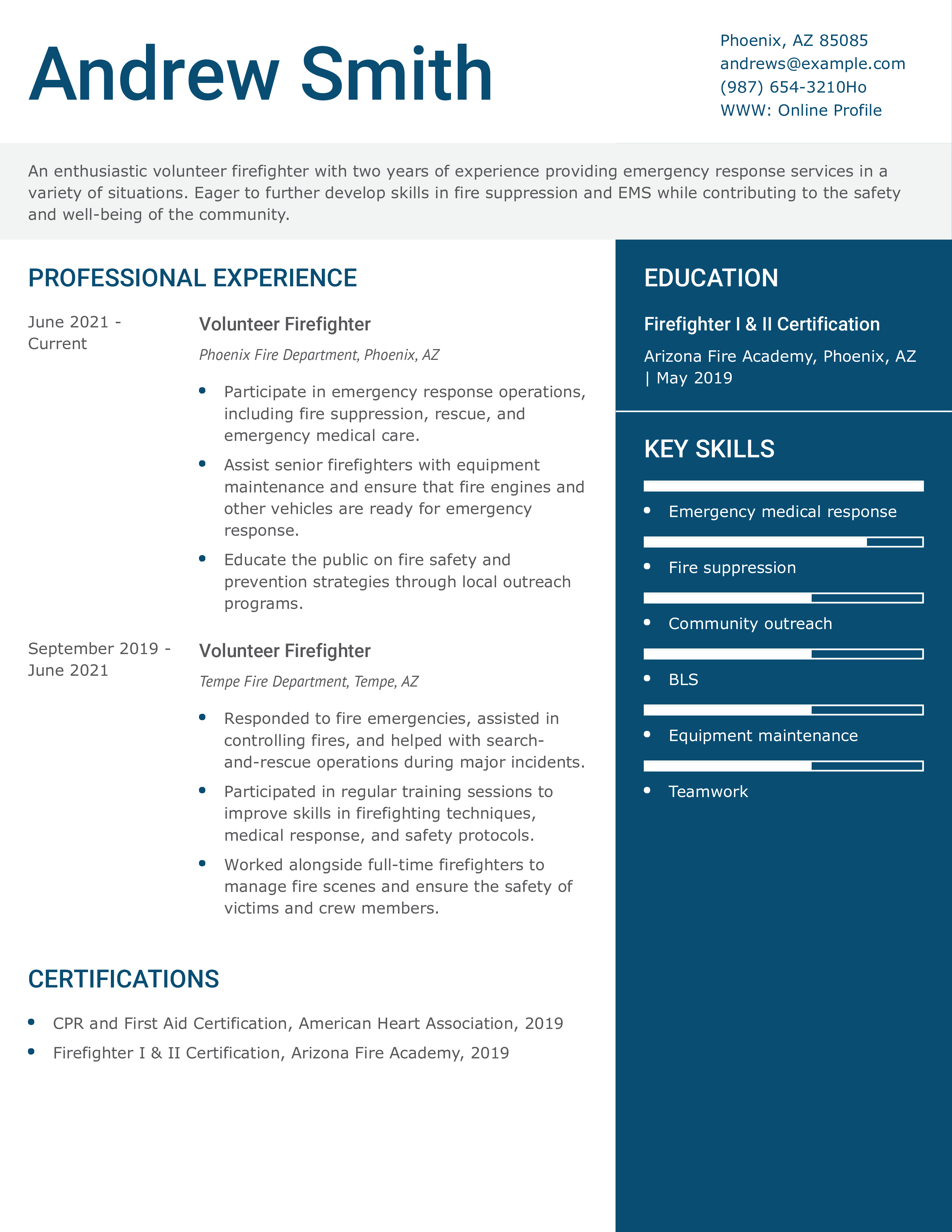
Why This Resume Works
This resume effectively showcases the candidate’s commitment to the fire service as a volunteer, highlighting both firefighting and emergency medical response skills. By demonstrating a willingness to learn and grow in the field through training and community outreach, the resume emphasizes a passion for helping others and contributing to public safety.
For more tips on highlighting volunteer work, check out How To Put Volunteer Work on Resume.
Mid-Level Firefighter EMT Resume
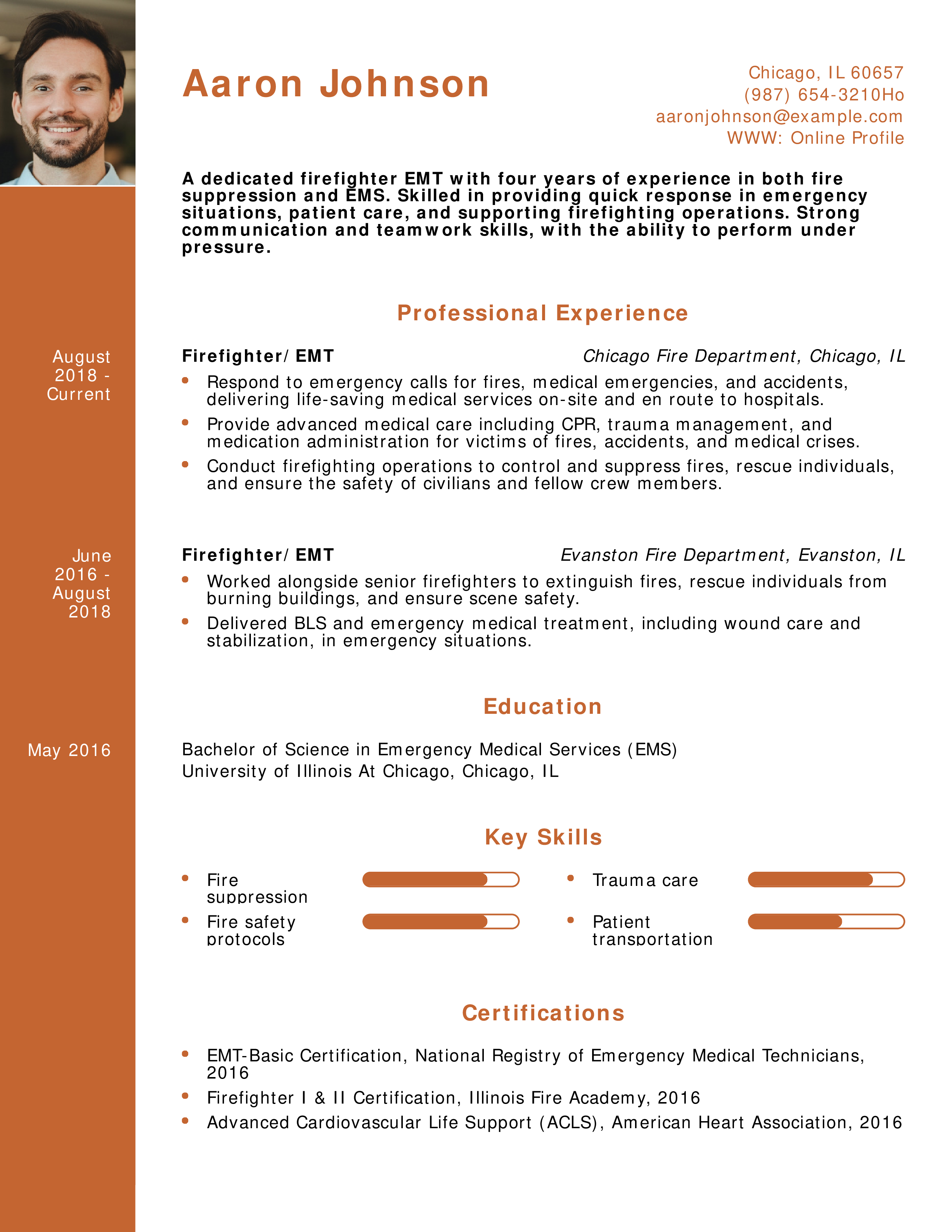
Why This Resume Works
This resume demonstrates the candidate’s dual expertise in both firefighting and EMS. It effectively highlights key certifications like EMT-Basic and Firefighter I & II, and emphasizes the candidate’s ability to perform under pressure. The experience section uses clear, action-oriented language that outlines the candidate’s capabilities in handling emergency situations.
For more tips on showcasing skills and qualifications, visit Resume Skills.
Mid-Level Firefighter Paramedic Resume
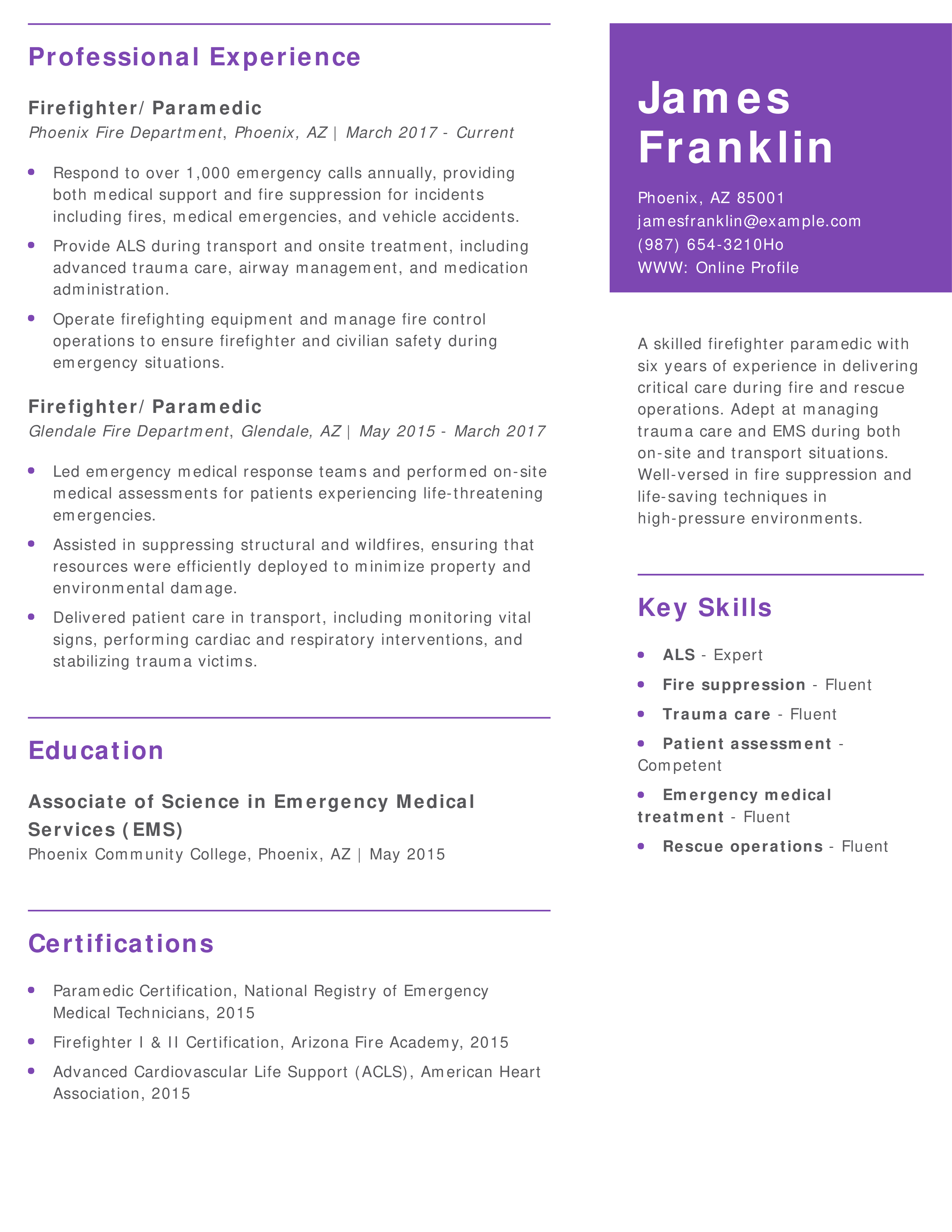
Why This Resume Works
This resume emphasizes both advanced medical and firefighting expertise, demonstrating the candidate’s comprehensive ability to respond to emergencies with efficiency and care. Key certifications and professional development are highlighted to showcase the candidate's qualifications for paramedic and firefighter roles. The use of specific metrics, such as responding to 1,000 calls annually, helps quantify the candidate’s experience.
For further tips on resume presentation, visit Best Resume Formats.
Wildland High-Risk Firefighter Resume
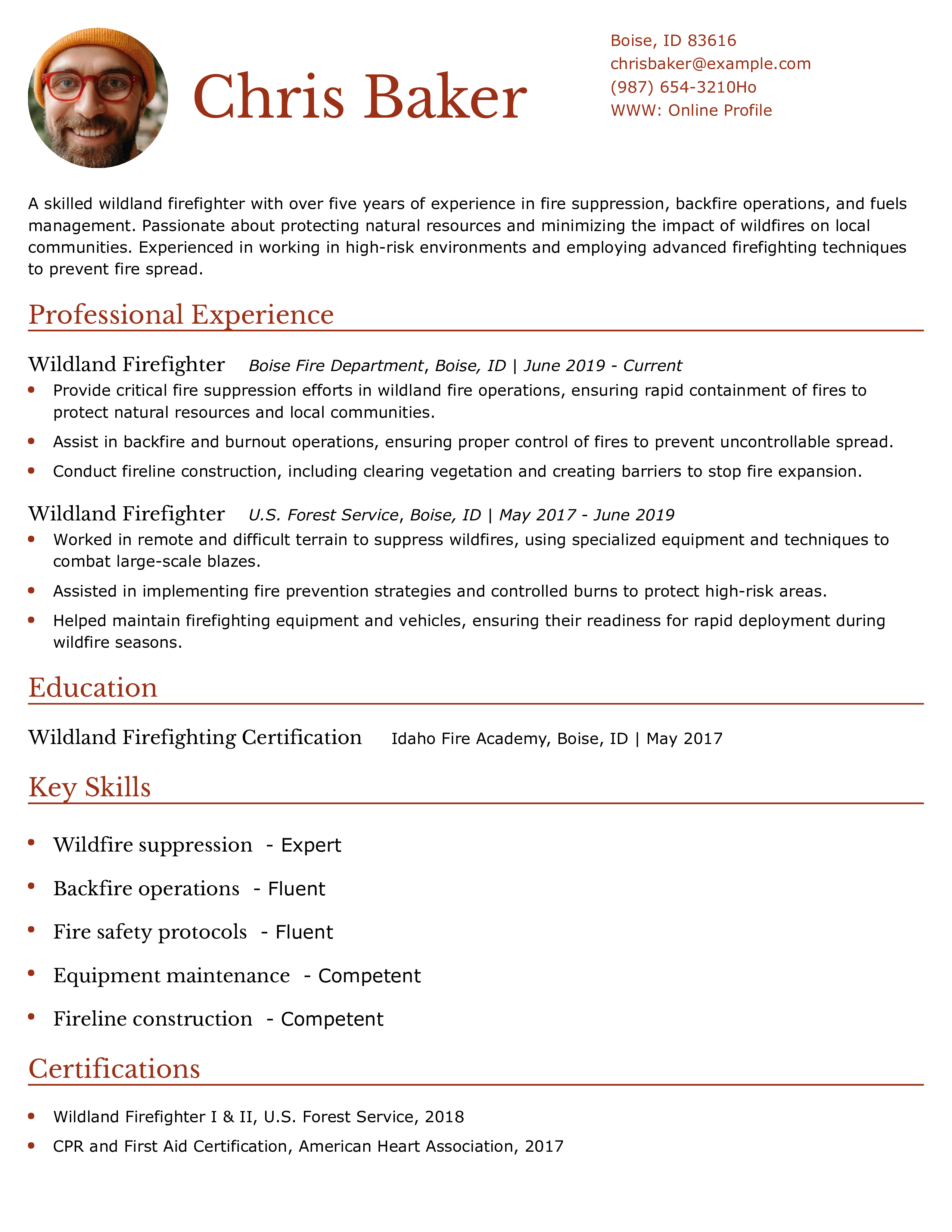
Why This Resume Works
This resume emphasizes the candidate’s specialized wildland firefighting experience and skills. By outlining specific tasks such as backfire operations and fireline construction, it illustrates the candidate’s hands-on involvement in critical firefighting processes. The certifications and work history further position this candidate as a qualified and experienced wildland firefighter.
To learn how to present your firefighting skills effectively, visit Resume Skills.
Advanced Firefighter Paramedic Resume
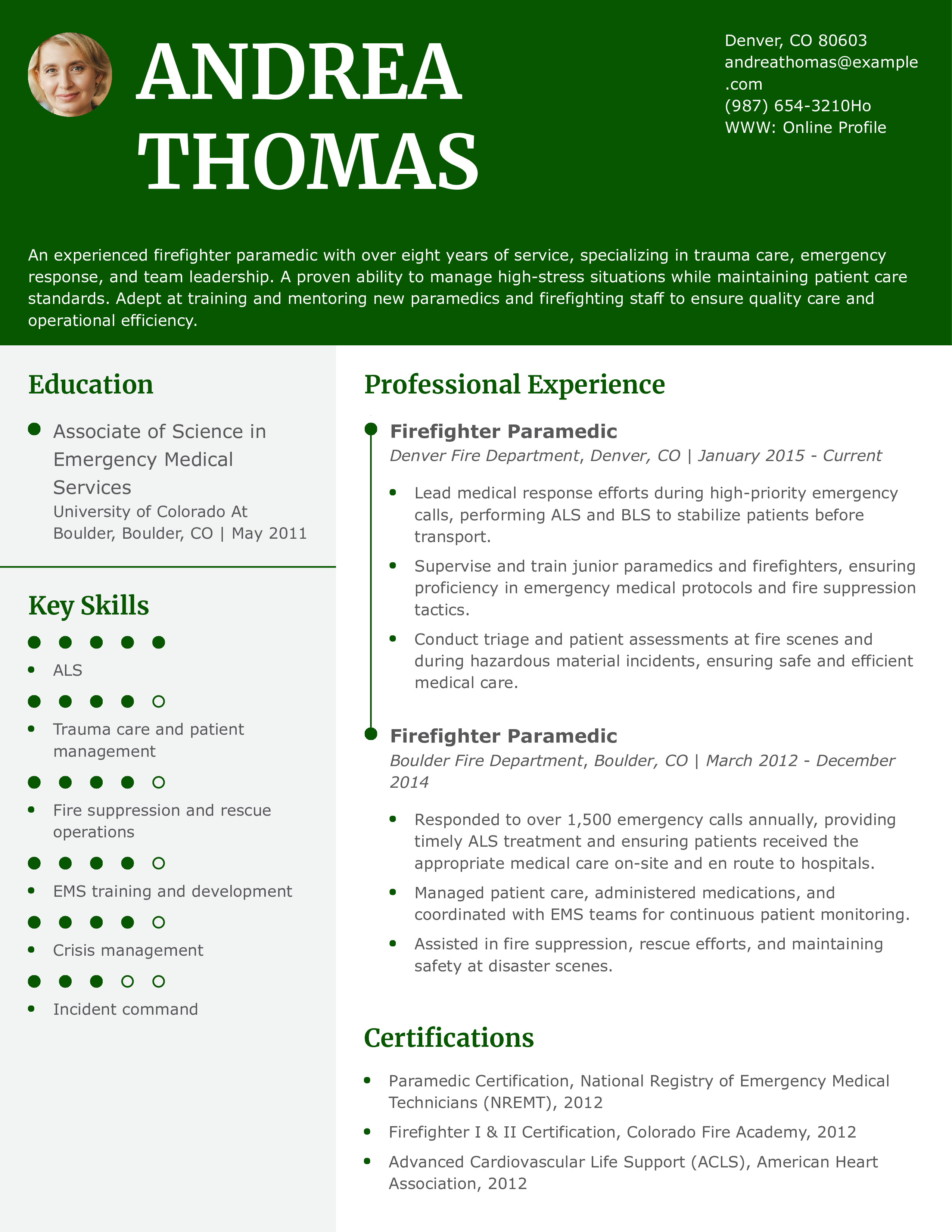
Why This Resume Works
This resume effectively demonstrates the candidate's advanced expertise in both firefighting and paramedic roles, emphasizing ALS experience and leadership in training and mentoring. Highlighting specific achievements such as managing high-priority emergency responses and supervising teams shows the candidate’s readiness for senior paramedic roles. The resume also showcases certifications that are crucial for advanced emergency medical and firefighting positions.
For additional insights into resume presentation, visit Best Resume Formats.
Firefighter EMT Paramedic Resume
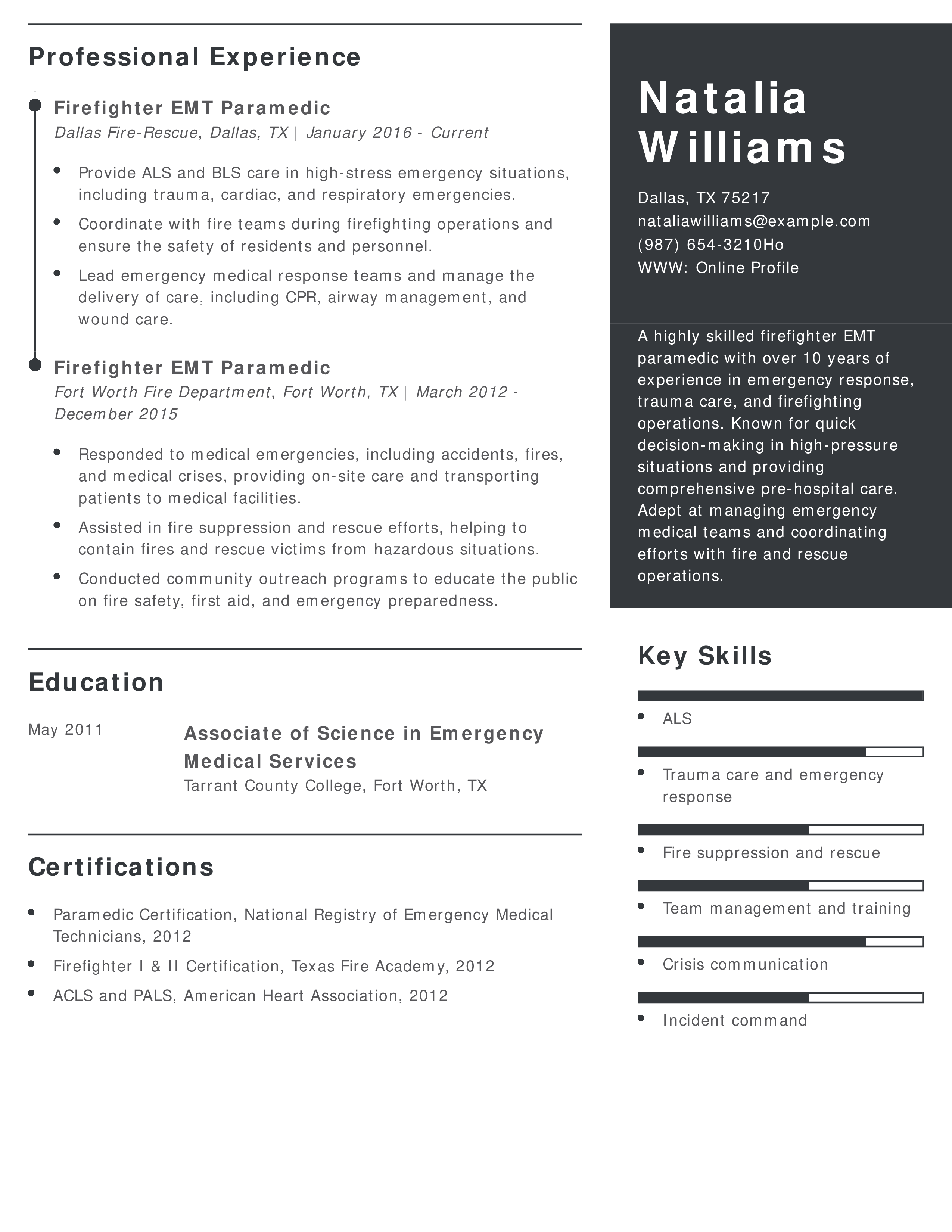
Why This Resume Works
This resume emphasizes the candidate’s dual expertise as a firefighter and paramedic, with leadership skills highlighted by managing emergency medical teams. The use of measurable actions and results, such as providing ALS and BLS care, showcases the candidate’s practical experience. Additionally, the inclusion of community outreach work strengthens the candidate’s profile for roles requiring both firefighting and emergency medical expertise.
For tips on including leadership in your resume, check out Resume Summary Examples.
Volunteer First Responder Resume
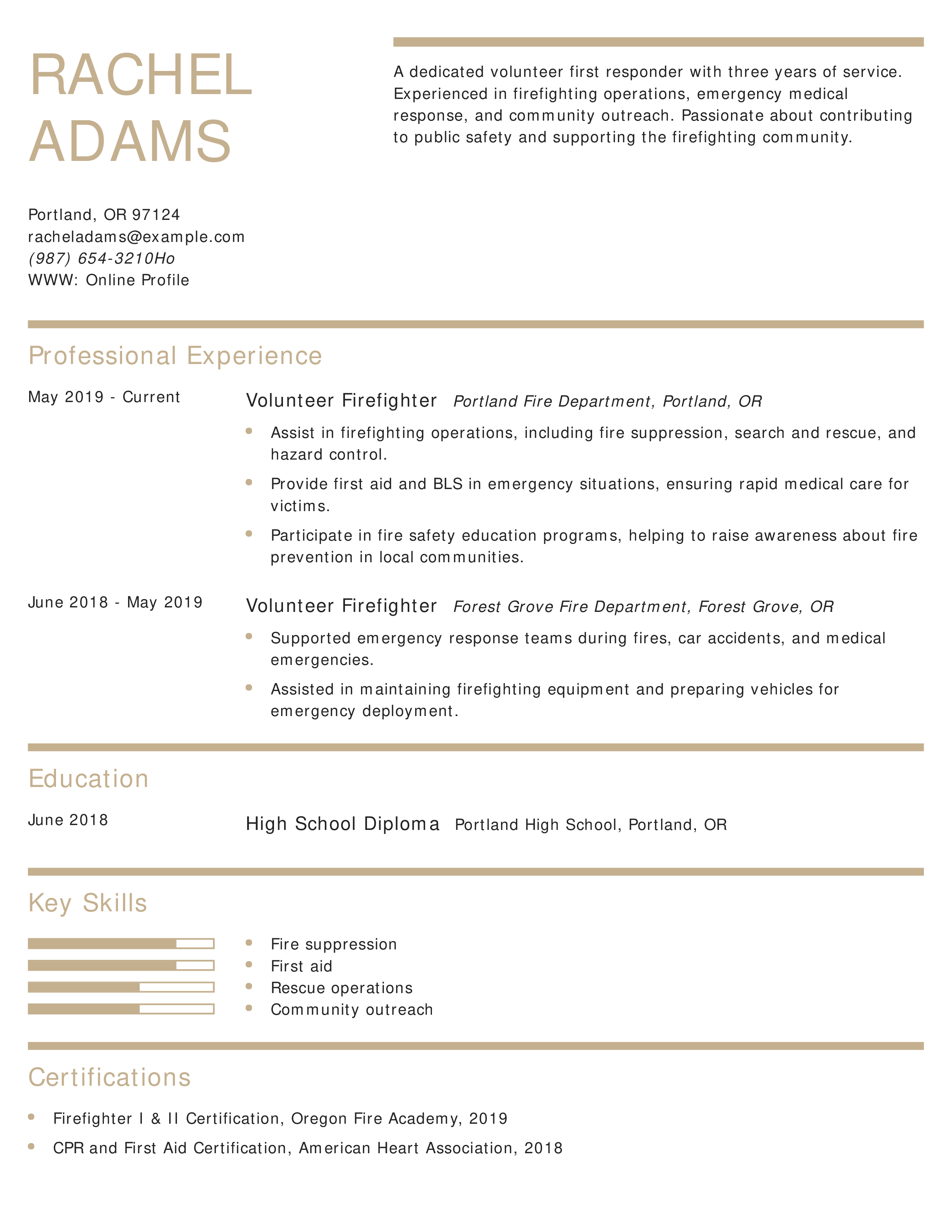
Why This Resume Works
This resume showcases the candidate’s volunteer first responder experience and commitment to serving their community. The resume emphasizes specific responsibilities, such as fire suppression and first aid, while highlighting certifications and community involvement in fire prevention.
For more tips on presenting volunteer work, visit How to Put Volunteer Work on Resume.
Wildland Fire Operations Technician Resume
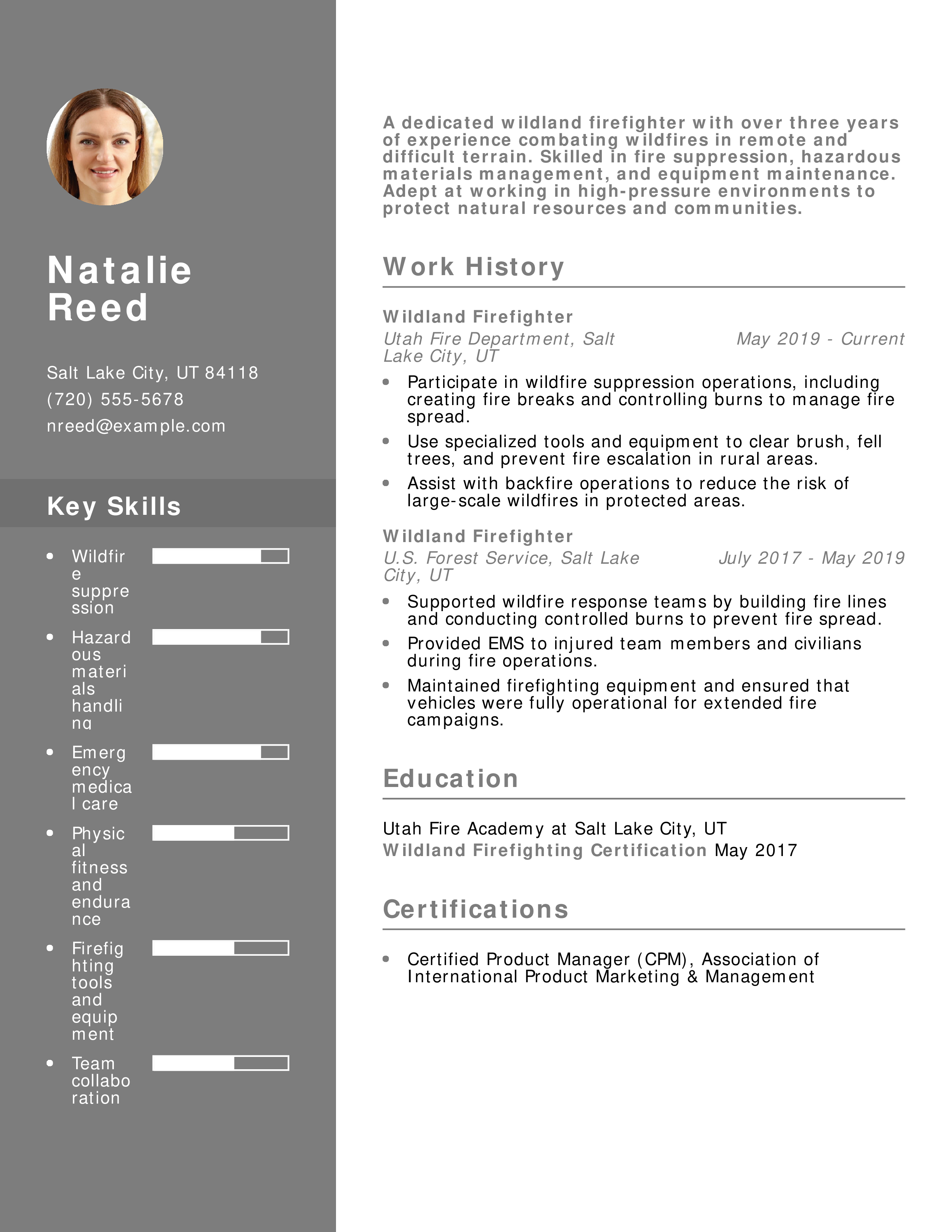
Why This Resume Works
This resume emphasizes the candidate’s specialized knowledge in wildland firefighting, showcasing expertise in fire suppression and hazardous materials handling. Highlighting practical experience in controlling fires and maintaining firefighting tools and equipment is key for potential employers looking for candidates with real-world experience.
For more guidance on listing relevant coursework and certifications, visit How to List Relevant Coursework on Resume.
Wildfire Incident Response Specialist Resume
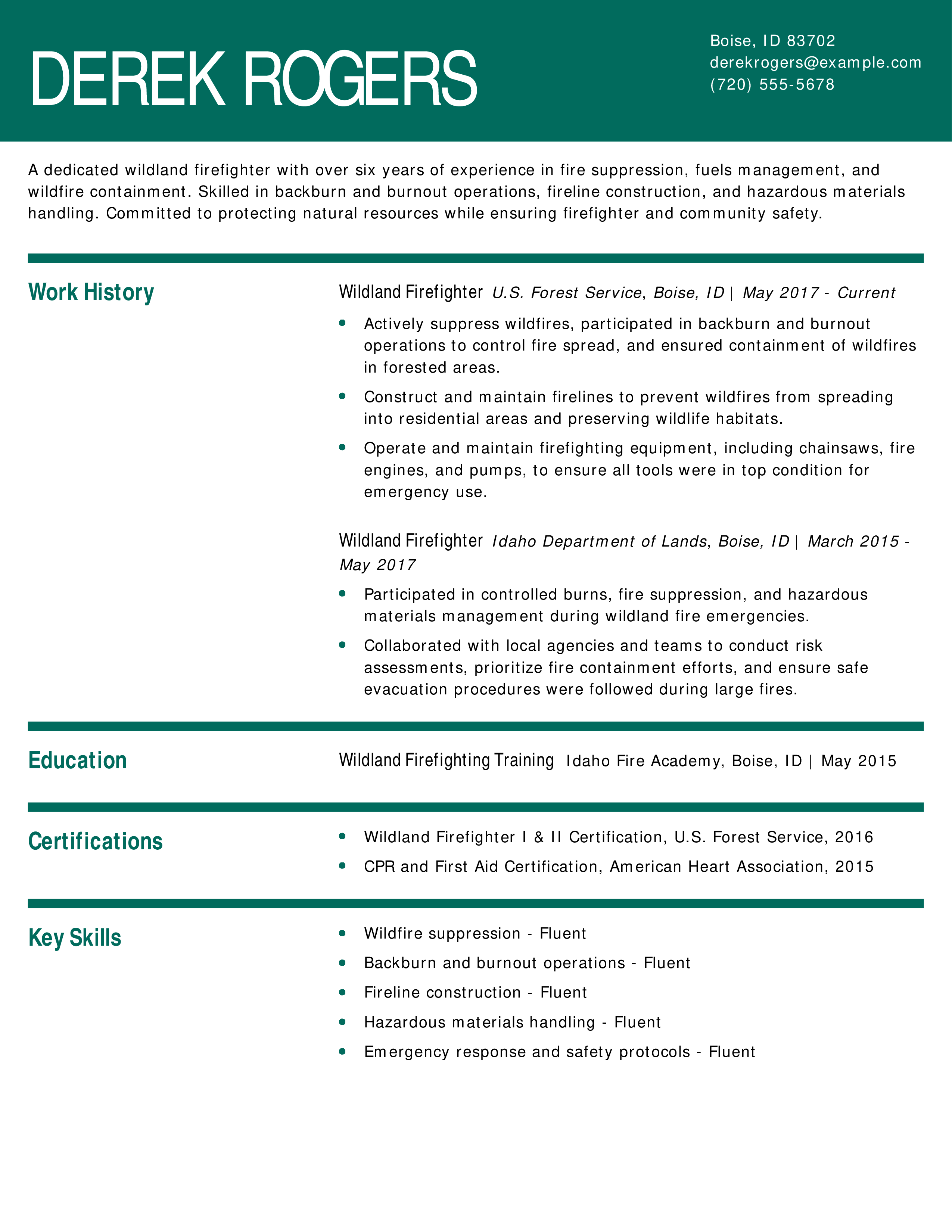
Why This Resume Works
This resume highlights the candidate’s specialized skills in wildland firefighting and firefighting techniques. The clear listing of backburn and burnout operations, fireline construction, and hazardous materials handling shows the candidate’s hands-on experience with complex wildfire suppression strategies. Key certifications and training further position the candidate as qualified for wildland firefighting roles.
Learn more about resume skills to enhance your resume.
Emergency Response Operations Supervisor Resume
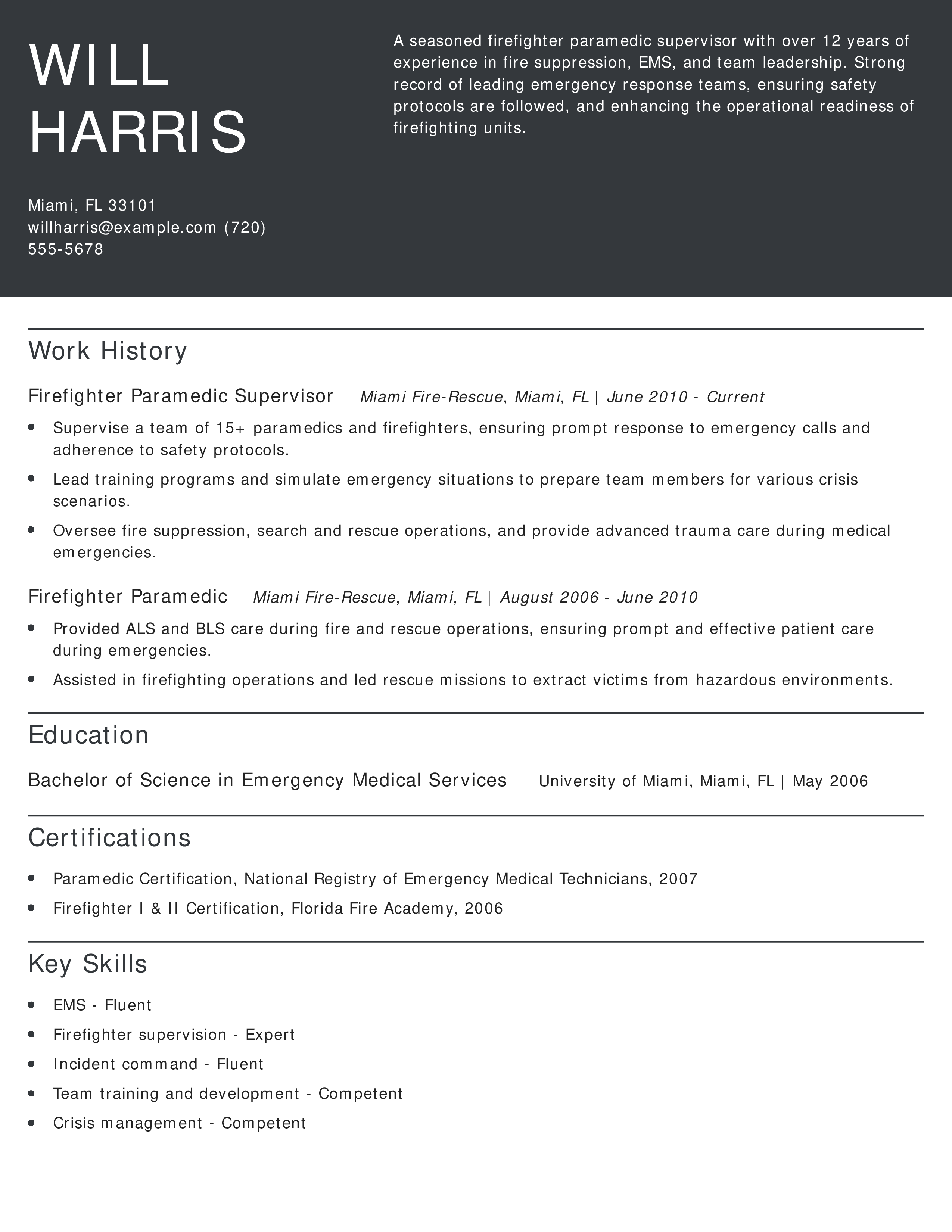
Why This Resume Works
This resume highlights the candidate’s leadership skills and experience supervising firefighting and medical teams. The supervisor role is clearly outlined with measurable achievements, such as leading training programs and ensuring operational readiness, which demonstrates the candidate’s readiness for high-level leadership roles.
For advice on presenting leadership experience, see Resume Outline Examples.
Senior Firefighter Resume
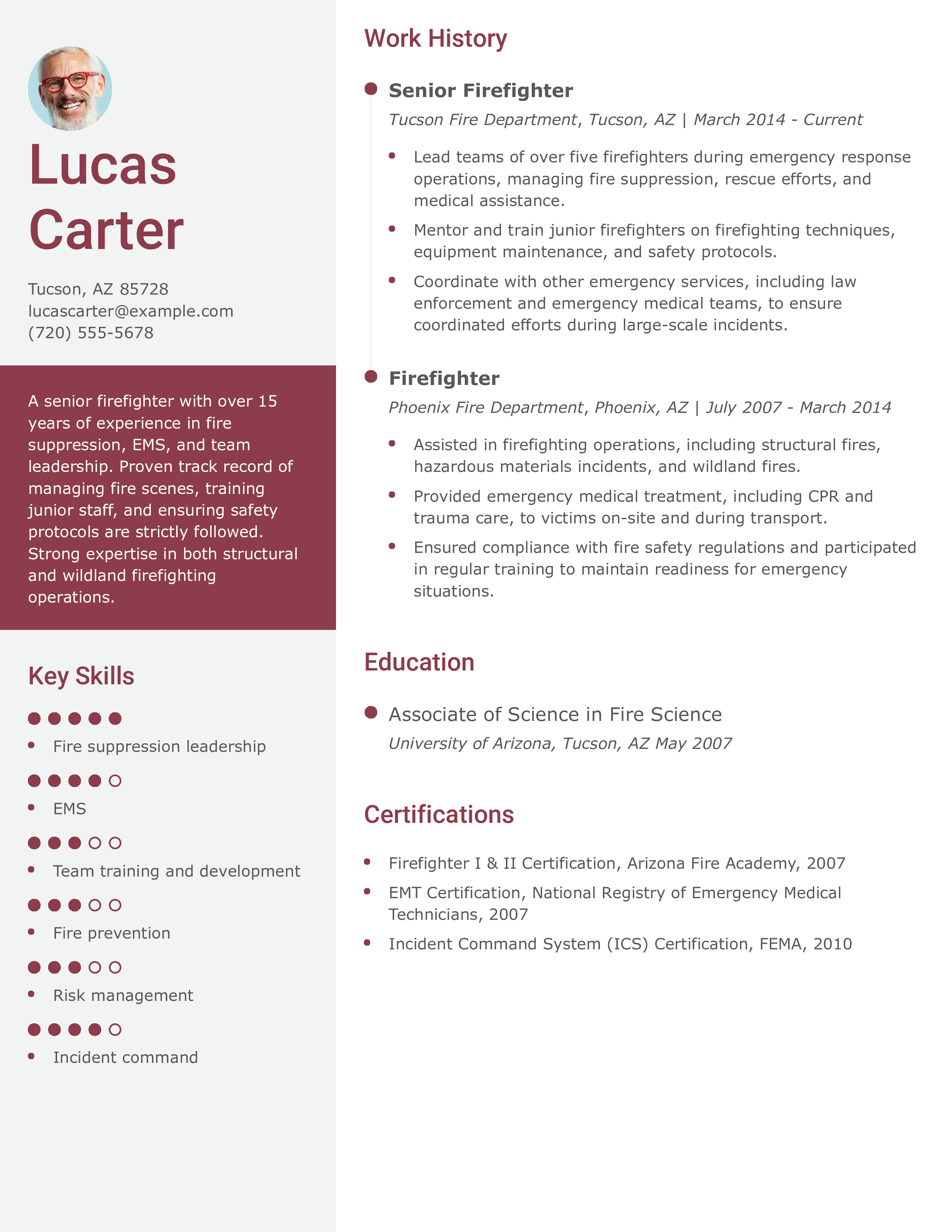
Why This Resume Works
This resume highlights the candidate’s senior-level experience and leadership in firefighting. It includes specific duties such as mentoring junior staff and leading firefighting operations, which are key qualities for senior roles. The emphasis on incident command and risk management illustrates the candidate's advanced expertise in managing emergency situations.
For further guidance on how to enhance your resume for leadership roles, check out Resume Outline Examples.
Our templates are crafted by professional resume writers to make creating your resume quick, easy, and effective.
- Professional resume template downloads
- Customized cover letter generation
- AI resume writing support
- Career-building resources and advice
Firefighter Text-Only Resume Templates and Examples
How To Write a Firefighter Resume
1. Craft an outstanding profile with a summary of your firefighter qualifications
Your resume profile should catch hiring managers’ interest by giving the top reasons they can expect you to respond to a fire quickly and effectively. What do you consider your key strengths in your field? What areas of the job have you shown high interest or ability in or been praised for the most? For example, maybe you have years of experience in a similar community or type of fire prevention. Or perhaps you recently won an award for diligence or efficiency in operating emergency vehicles. With relevant details like these in your profile, you can make a strong first impression and show you’re a great fit for the role.
Entry-Level Profile Example
Motivated and resourceful firefighter with two years of experience. Focused on raising public awareness and knowledge of fire prevention and safety topics. Skilled at calmly assessing situations, responding with solutions, and following instructions from senior firefighters.
Mid-Career Profile Example
Dedicated firefighter and EMT with extensive experience in fire prevention and helping victims of house fires and road traffic collisions. Fully certified and highly trained in various firefighting methods and safety measures. Committed to continuous learning.
2. Showcase your firefighter experience
View the Experience section as a chance to give examples of your success as a firefighter. These are the best ways to convince a hiring manager you can thrive.
Review your recent work history, and list duties and highlights for the firefighter jobs you’ve held so far, along with any other jobs where promptness and efficiency were critical. Try to quantify each past firefighter job with relevant data like the number of calls you answered or volunteers you led. Also, outline your preparations to help ensure the department’s readiness and efficiency in a crisis. Most importantly, spell out how your work helped save lives, prevent property loss, and protect the environment or community.
Mid-Career Experience Example
Firefighter / EMT, Los Angeles Fire Department, Los Angeles, CA | October 2018 to present
- Help quickly respond to disaster situations, evaluate risk, and contain and extinguish fires, handling ~10 calls per week
- Perform first aid or CPR on victims of smoke inhalation or other injuries
- Lead a team of four responders as needed
- Help maintain ladder truck, two ambulances, and six fire trucks to high standards
Senior-Level Experience Example
Firefighter I, City of Branson Fire Department, Branson, MO | January 2019 to present
- Ensure personnel (four onsite firefighters and six volunteers) and equipment are ready to respond promptly to EMS calls and fires
- Help inspect and repair department apparatus and equipment, including a ladder truck, two ambulances, and two fire trucks
- Administer first aid, life support, and other emergency medical care
- Draft weekly reports on department activities
3. Include education and certifications relevant to firefighters
Use the Education and Certifications sections to show you have a strong knowledge base for your target firefighter job. In addition to your highest education degree, consider giving details about the fire academy where you trained. Also, include your CPR certificate or other credentials for providing emergency medical services.
Below are templates and examples to help you format your education and certification details. Note that optional template areas appear in [brackets].
Education
Template
- Degree Name — [Major], School Name, City, ST | [Year]
Example
- Associate of Science in Fire Technology and Administration, Three Rivers Community College, Poplar Bluff, MO | 2012
Certification
Template
- Certification Name or Title, [Awarding Organization] | [Year]
Example
- CPR Certificate, American Red Cross | 2012
4. Outline your most useful firefighter skills and proficiencies
Add a Key Skills section to show how you can help respond to fires and other emergencies. Make sure each item overlaps with your target job, but otherwise, aim for variety in this section to cover your skills in teamwork, efficiency, emergency medicine, and community relations. Below are some common skills to consider for your firefighter resume.
| Key Skills and Proficiencies | |
|---|---|
| Basic Life Support (BLS) | Community outreach and education |
| Efficiency improvement | Emergency medical treatment |
| Emergency response | Equipment operation and maintenance |
| Fire prevention and safety | First aid |
| Group leadership | Process streamlining |
| Quality assurance | Rapid decision-making |
| Rapid problem-solving | Regulatory compliance |
| Reporting and documentation | Risk assessment |
| Team collaboration | |
How To Pick the Best Firefighter Resume Template
For firefighters, a clear and straightforward resume template is usually best. Opt for a visual design that lets the hiring manager quickly review your best career details. Select a traditional resume font, and avoid any template with a colorful or elaborate design. Also, make sure the template is compatible with applicant tracking systems (ATS) employers use to screen resumes.
Frequently Asked Questions: Firefighter Resume Examples and Advice
Should I use a Firefighter resume example even if I’m just starting my career?-
Yes, using a Firefighter resume example can provide guidance on structuring your resume, even if you’re at the beginning of your career. Focus on your internships, education, and skills that are transferable to the job you want. A strong entry-level resume example will highlight your potential and willingness to learn, making your limited experience a benefit.
What are common action verbs for firefighter resumes? -
One of the best ways to enhance your resume is by starting each bullet point with a strong action verb. Dynamic verbs help you keep the hiring manager’s attention and show the varied nature of your experience. The following list can help you find a good mix of action verbs for your firefighter resume:
| Action Verbs | |
|---|---|
| Adapted | Analyzed |
| Answered | Assessed |
| Climbed | Collaborated |
| Contained | Controlled |
| Coordinated | Directed |
| Educated | Entered |
| Examined | Extinguished |
| Generated | Handled |
| Improved | Investigated |
| Isolated | Led |
| Overcame | Prepared |
| Prevented | Provided |
| Ranked | Reacted |
| Rescued | Resolved |
| Responded | Retrieved |
| Strengthened | Supported |
| Won | |
How do you align your firefighter resume with a firefighter job posting?-
The Bureau of Labor Statistics forecasts that jobs for firefighters will increase by about 4% (or nearly 14,000 positions) between 2021 and 2031.
You can get more interviews in this growing field if you tailor your resume for each application. Start by looking at the job post and highlighting words that are repeated, emphasized, or otherwise seem important. Compare these highlighted phrases to the language you’re using in your resume, particularly the Profile and Key Skills sections. Then, look for ways to align your resume language with the job post while not copying phrases or misrepresenting your background.
For example, if the organization seeks someone highly collaborative, call out that aspect of your experience. Or, say, the department engages with many non-English community members. Consider highlighting your foreign language skills in your Profile and as a separate section farther down the document. With adjustments like these, you can make your resume more relevant to each new job opportunity.
What is the best firefighter resume format? -
In nearly all cases, use a Combination (or Hybrid) resume because it’s easiest for hiring managers to learn about your pertinent skills and experience. It’s also the simplest way to align with your job goals.
With the Combination format, you highlight your most relevant skills and experience in your Experience or Work History section and an intro section. (This combination of work history and intro content is where the format gets its name.) Your resume intro should usually include a Profile summary and Key Skills section, but you may also add a Career Highlights or Awards section. By carefully choosing the details for these intro sections, you can (a) position yourself for your target job and (b) give hiring managers a clear, quick view of what you offer.
How many pages should my firefighter resume be?-
Generally, a firefighter resume should be one page for candidates with fewer than 10 years of experience. A two-page resume is acceptable if you’re a seasoned professional with extensive accomplishments—but only if it provides meaningful details that strengthen your application. Tailor your content to the job, focusing on your most relevant qualifications.
Work history should typically cover the last 10 to 15 years. Older positions can be excluded or briefly summarized unless they’re highly relevant. A concise, focused resume demonstrates your ability to prioritize and communicate effectively.
Craft your perfect resume in minutes
Get 2x more interviews with Resume Builder. Access Pro Plan features for a limited time!

To increase your chances of an interview, write and submit a strong cover letter. The key to an effective letter is customizing it based on each job opening. Read our Firefighter cover letter guide to learn how. For other related examples, see our Police Officer and Security Guard cover letter guides.
